Touring the Yucatan peninsula
Cycling 250 miles from Merida to Tulum
I was riding on a bus through a small town called Acanceh in Yucatan, Mexico, when I caught a glimpse of a Mayan pyramid right next to a colonial church in the middle of town. I made a note to come back and I followed through a year later. Every time I visit this amazing part of the world I come back with a longer list of places to visit. When my sister and her husband rented a villa in Akumal, Quintana Roo and invited me along with the rest of the family to join them I already had a list of places to see. I have also been wanting to do a short international bike tour and this looked like the perfect opportunity. Yucatan was a great choice for my first tour because it's warm,  relatively flat with delicious food and plenty of adventure. I accepted the invite, telling them I'd join them at the end of my ride. My friend Gina was able to take a few days off and was going to be joining me for part of the way. I did lots and lots of reading of other people's experiences bike touring the peninsula and put together a rough itinerary. I stuffed my touring bike into a box and set off to the airport.
relatively flat with delicious food and plenty of adventure. I accepted the invite, telling them I'd join them at the end of my ride. My friend Gina was able to take a few days off and was going to be joining me for part of the way. I did lots and lots of reading of other people's experiences bike touring the peninsula and put together a rough itinerary. I stuffed my touring bike into a box and set off to the airport.
I arrived in the Cancun airport, met up with Gina, and got straight on bus to Merida. We spent three days relaxing, seeing the sights, eating the 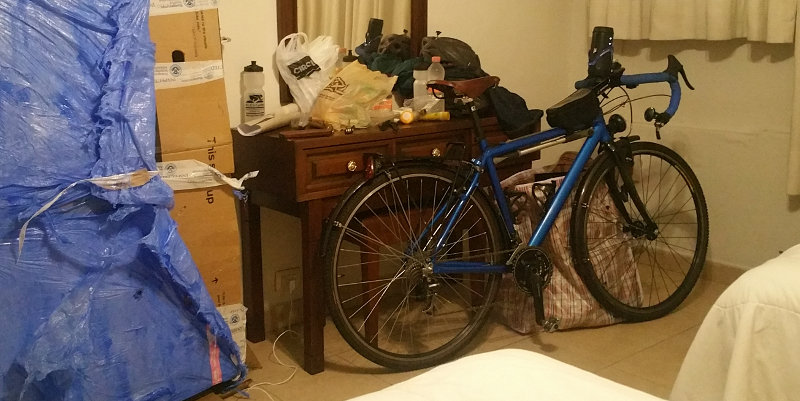 food and drinking the drinks in the capital of the state of Yucatan. Gina needed to buy a bike which we were able to accomplish at a dealership in the north of the city. I reassembled my bike in my hotel room. On our last night my Yucatecan friend, Carolina, invited us to a Mexican holiday posada which came complete with a Mariachi band, a piñata, and lots of cervezas and tequilas. It was a blast though we might have had a little too much fun given how much effort the next few days were going to require.
food and drinking the drinks in the capital of the state of Yucatan. Gina needed to buy a bike which we were able to accomplish at a dealership in the north of the city. I reassembled my bike in my hotel room. On our last night my Yucatecan friend, Carolina, invited us to a Mexican holiday posada which came complete with a Mariachi band, a piñata, and lots of cervezas and tequilas. It was a blast though we might have had a little too much fun given how much effort the next few days were going to require.
Day 1 — Merida to Ticul — 50 miles
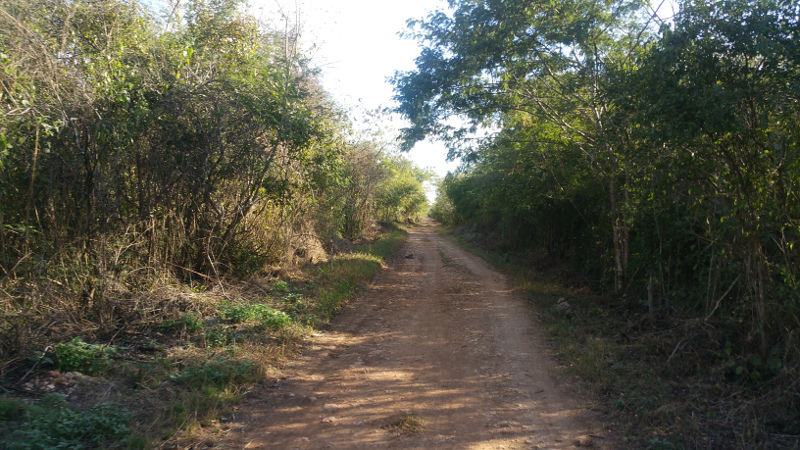 After a little recovery time and a much needed hearty breakfast, we got on the road headed south. The downtown is very busy with traffic of all kinds and we wanted to avoid riding in it as best as we could. Luckily the congestion diminished significantly only a few blocks past the center. We took Calle 50 going towards the town of Molas. Near the outer edge of Merida we rode a paved bike lane of sorts that ran along the main road. It took us a few kilometers past the city's outer ring down to where there was barely any traffic.
After a little recovery time and a much needed hearty breakfast, we got on the road headed south. The downtown is very busy with traffic of all kinds and we wanted to avoid riding in it as best as we could. Luckily the congestion diminished significantly only a few blocks past the center. We took Calle 50 going towards the town of Molas. Near the outer edge of Merida we rode a paved bike lane of sorts that ran along the main road. It took us a few kilometers past the city's outer ring down to where there was barely any traffic. 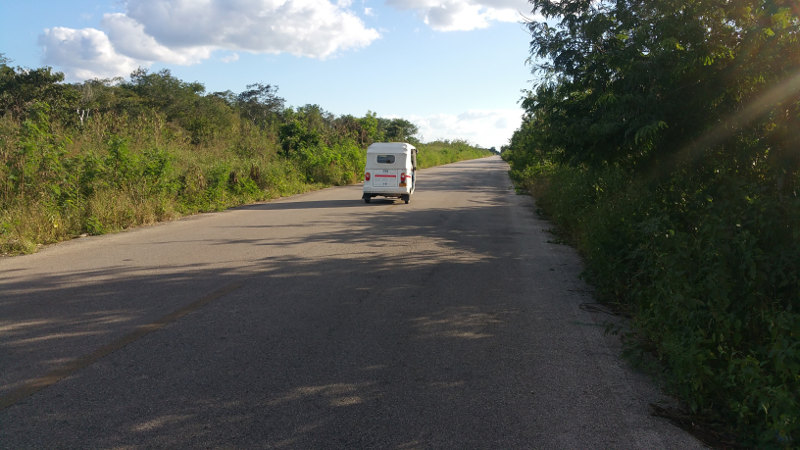 We missed our turn and wound up in a small town called Dzununcan where we refilled our water bottles. Retracing the last few steps we realized why we missed our turn. The road we were looking for turned out to be an unpaved dirt path that was, to my surprise,
mapped the whole way by Google maps including street views. Riding a rocky dirt road slowed us down significantly but it looked like it was only going to be like this until the next town.
We missed our turn and wound up in a small town called Dzununcan where we refilled our water bottles. Retracing the last few steps we realized why we missed our turn. The road we were looking for turned out to be an unpaved dirt path that was, to my surprise,
mapped the whole way by Google maps including street views. Riding a rocky dirt road slowed us down significantly but it looked like it was only going to be like this until the next town.
 Indeed, the road we connected to was well paved. We were basically the only ones on it except a few moto-taxis along with the occasional car. After a mile or so, however, the road surface turned to rocky, beat up asphalt. We asked a few locals for advice and decided to circumvent this stretch.
Indeed, the road we connected to was well paved. We were basically the only ones on it except a few moto-taxis along with the occasional car. After a mile or so, however, the road surface turned to rocky, beat up asphalt. We asked a few locals for advice and decided to circumvent this stretch. 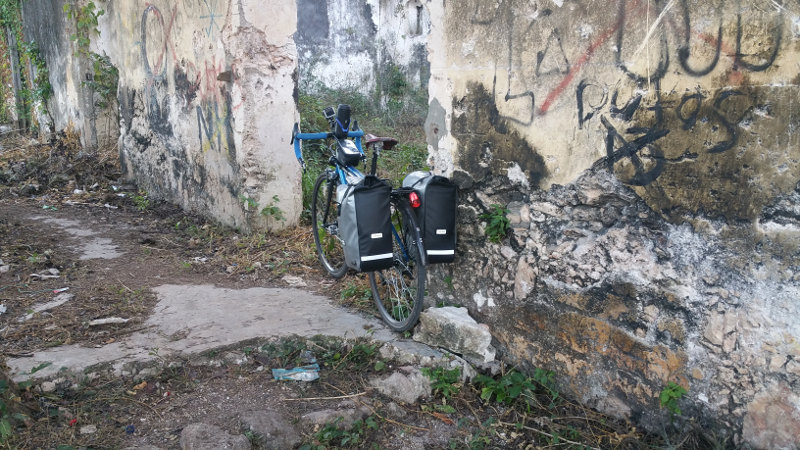 We were lucky to have the option as many towns in the area didn't have a second road to choose. The one we took was a much better option. It was better paved and wider but there still wasn't much traffic in either direction. The pavement was smooth and the sun wasn't as hot so we were able to up our pace a bit. A little beyond the half-way point of the day's trip we rode into the tiny town of Uayalceh, notable for having the remains of a 17th century hacienda. I later noticed there were several excellent cenotes nearby as well. A group of people were gathering in the courtyard of the hacienda to set up for their holiday festivities. They were building a large circle pen for some sort of sporting activity. They invited us to stay, saying they only did this twice
We were lucky to have the option as many towns in the area didn't have a second road to choose. The one we took was a much better option. It was better paved and wider but there still wasn't much traffic in either direction. The pavement was smooth and the sun wasn't as hot so we were able to up our pace a bit. A little beyond the half-way point of the day's trip we rode into the tiny town of Uayalceh, notable for having the remains of a 17th century hacienda. I later noticed there were several excellent cenotes nearby as well. A group of people were gathering in the courtyard of the hacienda to set up for their holiday festivities. They were building a large circle pen for some sort of sporting activity. They invited us to stay, saying they only did this twice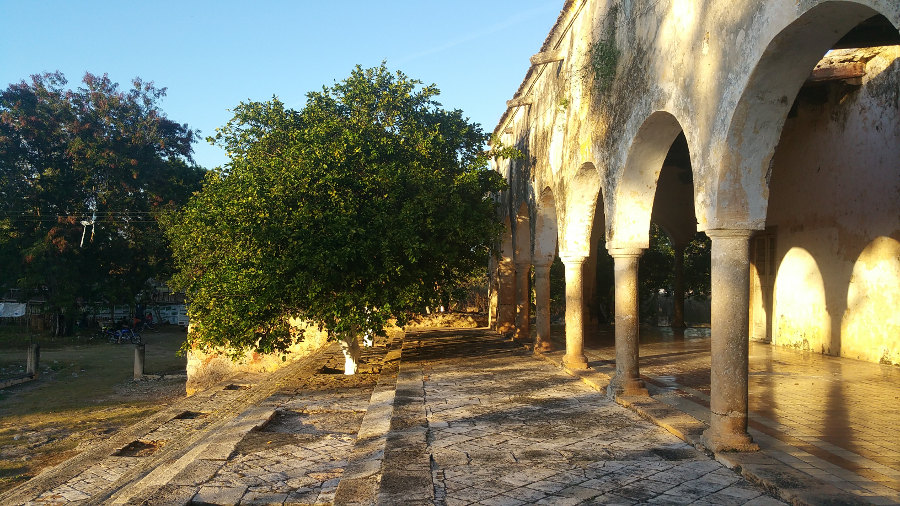 a year but as curious as we were time was not on our side. We still had about 20 miles to go and not a lot of daylight. We took a quick tour of the ruins and got back on the road.
a year but as curious as we were time was not on our side. We still had about 20 miles to go and not a lot of daylight. We took a quick tour of the ruins and got back on the road.
The part of the country we were in now felt like a world away from the bustle of Merida. It was truly blissful riding with so little traffic, the green scenery and quaint little towns. There weren't any lights on the road so we definitely needed to ride a little faster. I put my lights on and lent Gina a flashlight once the sun went down and we soon arrived in the last town before our destination, Sacalum. We stopped for a rest and some food. Out of curiosity we asked about a hotel so we didn't have to ride in the dark but there weren't really any good options. 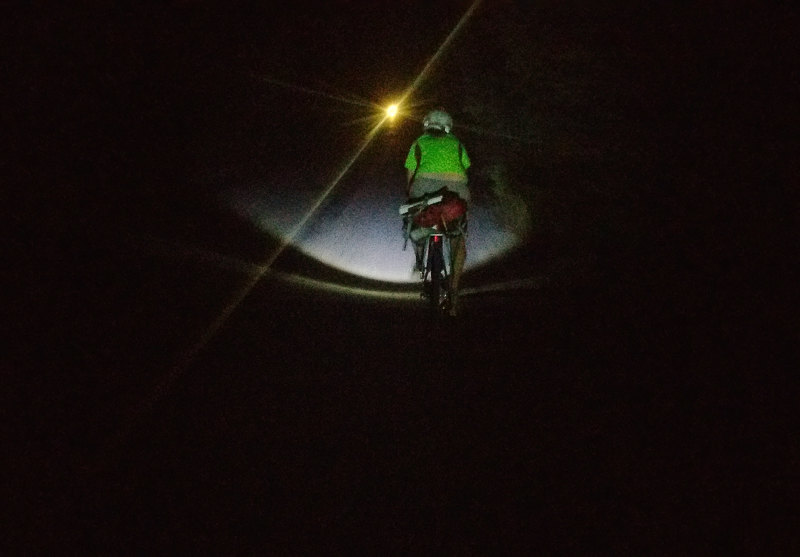 I saw the same cirle pen setup as the one in Uayalceh though I still wasn't sure what it was for. I saw a man in there on horseback but couldn't
I saw the same cirle pen setup as the one in Uayalceh though I still wasn't sure what it was for. I saw a man in there on horseback but couldn't 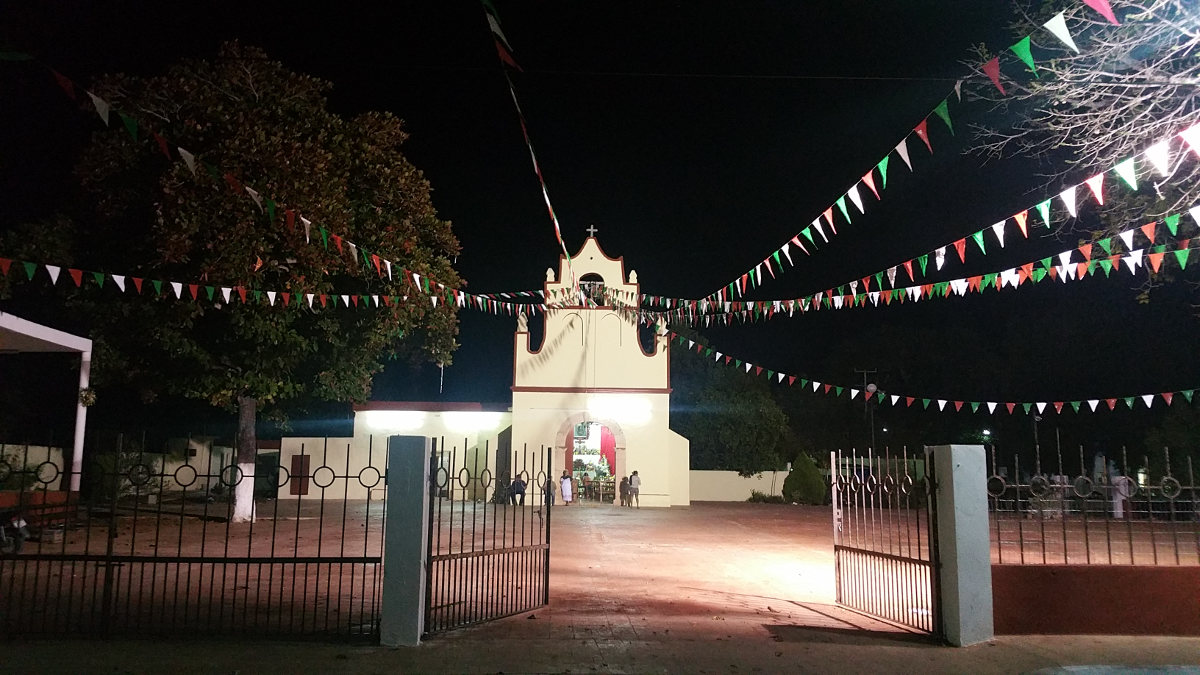 tell what animal he was supposed to be battling. After a break and some flautas we decided to get back on the road to finish the trip and about 8 miles later we finally arrived in Ticul.
tell what animal he was supposed to be battling. After a break and some flautas we decided to get back on the road to finish the trip and about 8 miles later we finally arrived in Ticul.
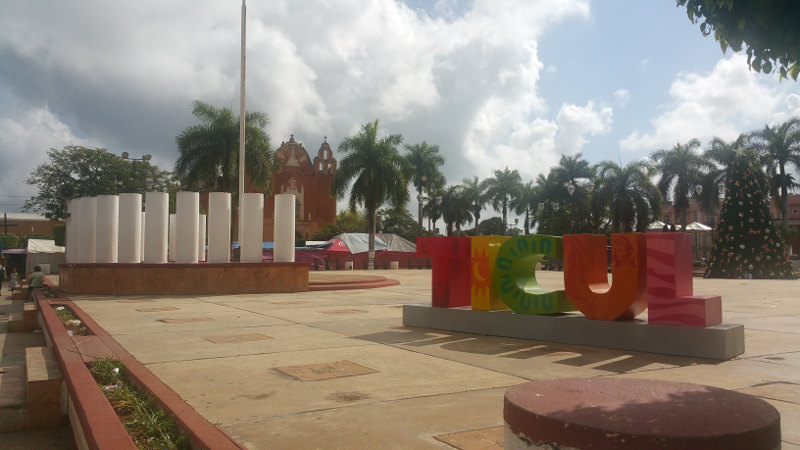 Ticul is known for leather shoe production and pottery. It was also one of the larger towns with hotels near the Ruta Puuc which was on the itinerary. We checked into a hotel right in the heart of the city and walked around the main square. There were no other tourists in sight but crowds people were out enjoying the holiday festivities. There was a large fair with all kinds of goods being sold in the town square. We got ice cream and a marquesita which is a hot crepe-like desert made with cheese and jam filling. Not much later the activity in town seemed to be dying down. Gina went to lie down and I got a few tacos from the only place that still seemed open. I was pretty tired and sore myself so I called it a night pretty early.
Ticul is known for leather shoe production and pottery. It was also one of the larger towns with hotels near the Ruta Puuc which was on the itinerary. We checked into a hotel right in the heart of the city and walked around the main square. There were no other tourists in sight but crowds people were out enjoying the holiday festivities. There was a large fair with all kinds of goods being sold in the town square. We got ice cream and a marquesita which is a hot crepe-like desert made with cheese and jam filling. Not much later the activity in town seemed to be dying down. Gina went to lie down and I got a few tacos from the only place that still seemed open. I was pretty tired and sore myself so I called it a night pretty early.
Day 2 — Ticul to Oxcutzcab — 44 miles
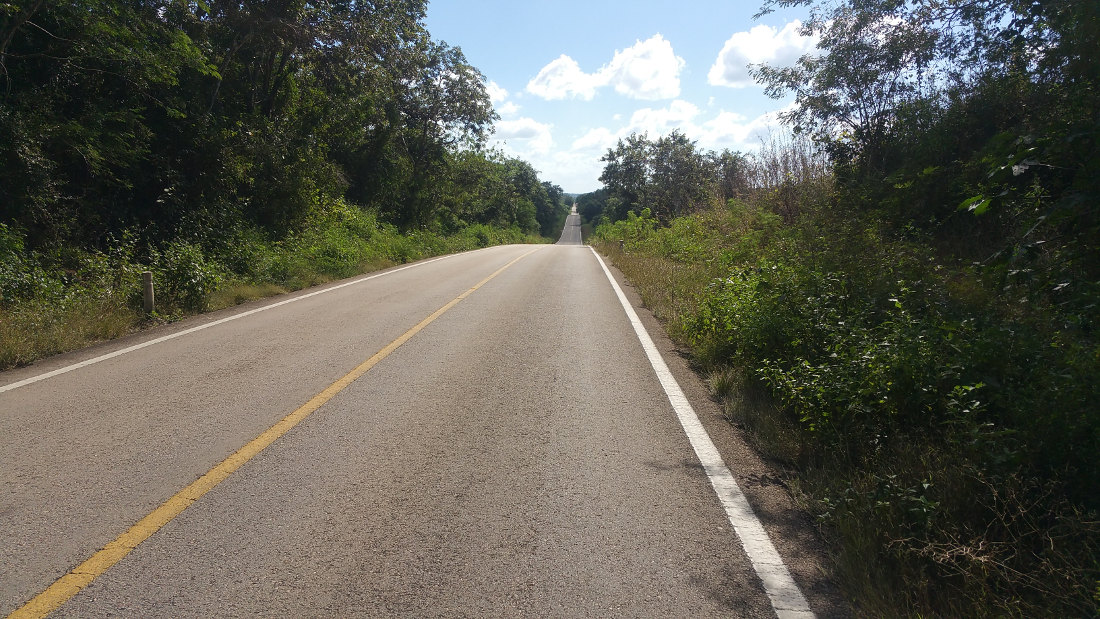 I woke up to the news that Gina wasn't feeling well and wouldn't be joining me on the day's ride. We made arrangements to meet in the next town and I packed my stuff, checked out of the hotel and headed west. The plan for the day was to ride the Ruta Puuc, a series of small roads boasting five impressive Mayan ruins. I've already been to the most famous one of them, Uxmal. That trip was three years ago and my first time in Mexico. We stopped in Uxmal on the drive from Merida to Campeche. As we kept going I was able to spot some of the ruins of Kabah from the road but we didn't have the time to stop in and explore. Again I made a mental note to return. On this visit I would explore Kabah and three more sites that see much less tourist traffic than Uxmal.
I woke up to the news that Gina wasn't feeling well and wouldn't be joining me on the day's ride. We made arrangements to meet in the next town and I packed my stuff, checked out of the hotel and headed west. The plan for the day was to ride the Ruta Puuc, a series of small roads boasting five impressive Mayan ruins. I've already been to the most famous one of them, Uxmal. That trip was three years ago and my first time in Mexico. We stopped in Uxmal on the drive from Merida to Campeche. As we kept going I was able to spot some of the ruins of Kabah from the road but we didn't have the time to stop in and explore. Again I made a mental note to return. On this visit I would explore Kabah and three more sites that see much less tourist traffic than Uxmal. 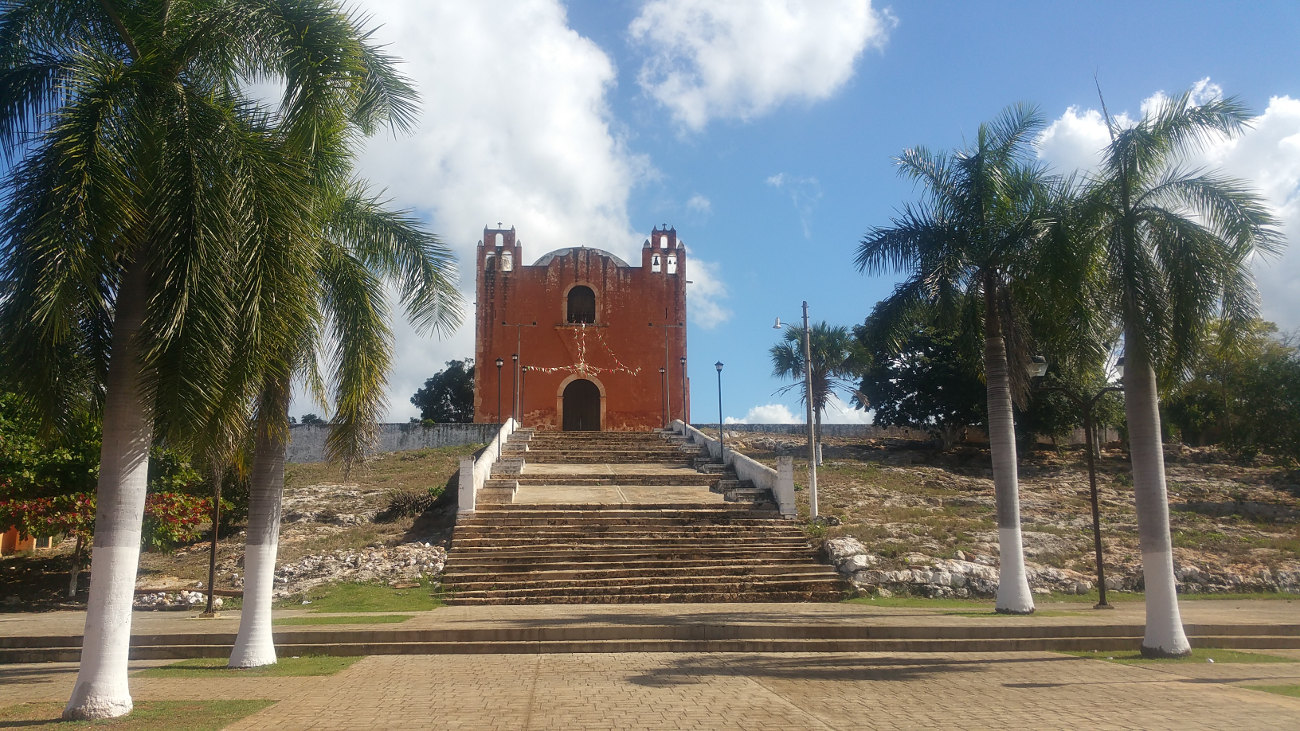 The day's distance was going to be lower than the day before but this was the only day of any significant climbing. Puuc is the Mayan word for hill and the terrain in this part of the state is comprised of small rolling green hills. The biggest hill I would have to ride on the entire tour was the one on the short ride from Ticul to Santa Elena. I needed a couple breaks to get over the hill mostly because of the intense late morning heat but the downhill was pretty exhilerating.
The day's distance was going to be lower than the day before but this was the only day of any significant climbing. Puuc is the Mayan word for hill and the terrain in this part of the state is comprised of small rolling green hills. The biggest hill I would have to ride on the entire tour was the one on the short ride from Ticul to Santa Elena. I needed a couple breaks to get over the hill mostly because of the intense late morning heat but the downhill was pretty exhilerating.
Santa Elena is a small town with a pretty red church on a hill. The church, like many in the region was built with stones taken from Mayan temples by the Spanish. 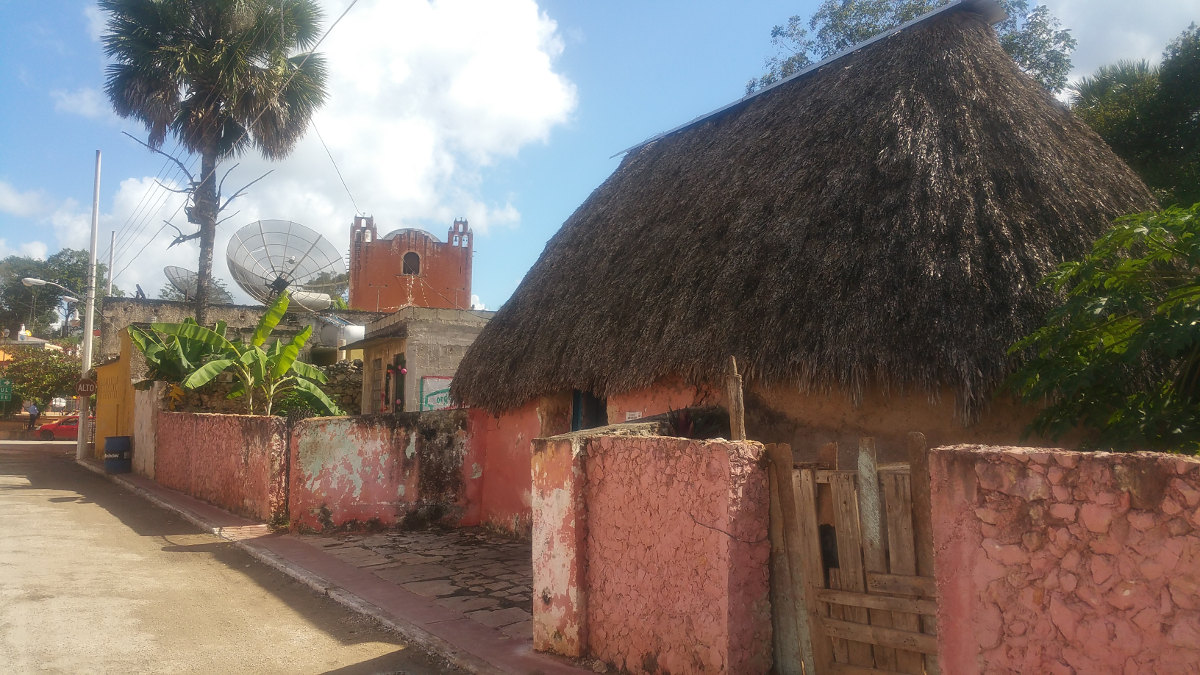 Long before the conquistadores arrived, Santa Elena was a Mayan town called Nohcacab. Many generations of history express themselves in one small town. Traditional Mayan houses called palapas with palm leaf roofs still stand in the center of town amongst more modern buildings. Santa Elena also has a few nice hotels for visitors to the Puuc region along with some stores and restaurants. I ate one of the mandarin oranges I brought and refilled my water bottles with some ice before continuing my trip.
Long before the conquistadores arrived, Santa Elena was a Mayan town called Nohcacab. Many generations of history express themselves in one small town. Traditional Mayan houses called palapas with palm leaf roofs still stand in the center of town amongst more modern buildings. Santa Elena also has a few nice hotels for visitors to the Puuc region along with some stores and restaurants. I ate one of the mandarin oranges I brought and refilled my water bottles with some ice before continuing my trip.
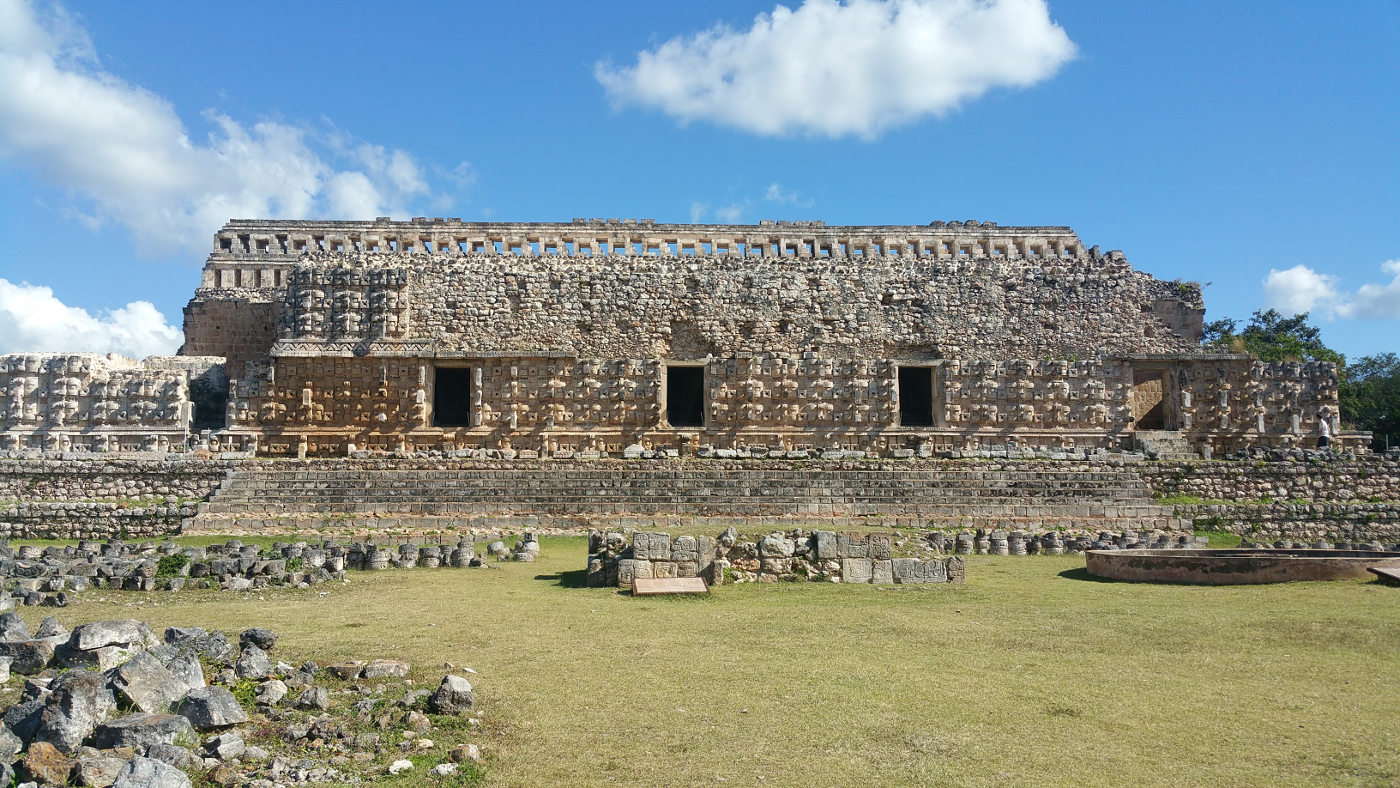 A short distance down the road south of Santa Elena lie the ruins of Kabah. I was greeted at the gate by an enthusiastic puppy as I rode up to the site. The ruins are contained in a small area, easily walkable in a few minutes but the structures they contain are breathtaking. The majority of the site was built between the 7th and 11th century AD, yet the delicate masks lining the facade of the most prominent palace, the Codz Poop, were largely intact.
A short distance down the road south of Santa Elena lie the ruins of Kabah. I was greeted at the gate by an enthusiastic puppy as I rode up to the site. The ruins are contained in a small area, easily walkable in a few minutes but the structures they contain are breathtaking. The majority of the site was built between the 7th and 11th century AD, yet the delicate masks lining the facade of the most prominent palace, the Codz Poop, were largely intact.  There were a few lizards soaking up sun's rays on the hot rocks. Across the road from the main entrance was another portion of the site containing a stone arch, one of the iconic features of the Puuc region's architecture. I thought the ruins of Kabah alone were worth the trip and I could have spent more time exploring them but I had several more sites to visit.
There were a few lizards soaking up sun's rays on the hot rocks. Across the road from the main entrance was another portion of the site containing a stone arch, one of the iconic features of the Puuc region's architecture. I thought the ruins of Kabah alone were worth the trip and I could have spent more time exploring them but I had several more sites to visit.
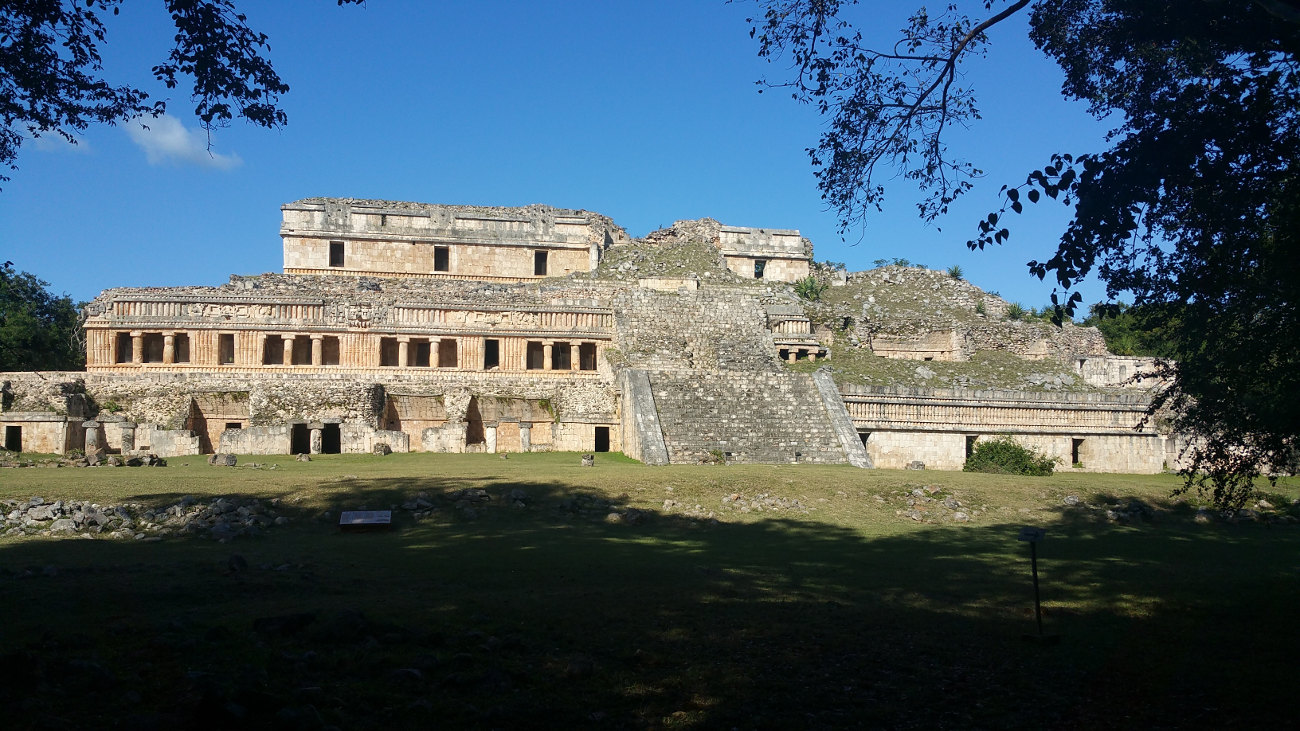 A few miles and several hills further south was the beginning of the tiny road on which three more Mayan sites are situated. The very beginning of the road was under construction. It was dusty and a little frustrating to get through but once I passed it the ride to the next archeological site was short and simple. Sayil took up a larger footprint that Kabah. The largest temple was located closest to the entrance but there were several more structures nearby.
A few miles and several hills further south was the beginning of the tiny road on which three more Mayan sites are situated. The very beginning of the road was under construction. It was dusty and a little frustrating to get through but once I passed it the ride to the next archeological site was short and simple. Sayil took up a larger footprint that Kabah. The largest temple was located closest to the entrance but there were several more structures nearby. 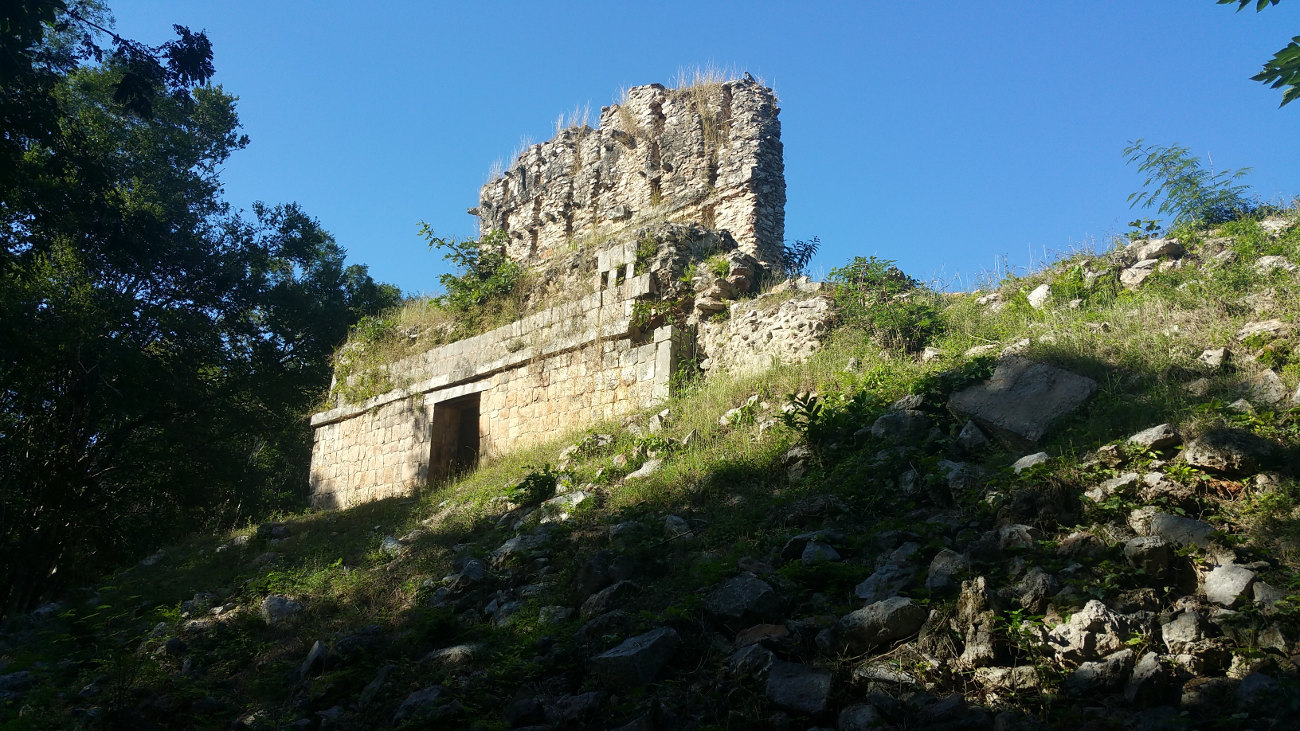 There were markings that gave distances between the different buildings in hundreds of meters and after a few long walks my legs were starting to feel a little heavy. I wasn't sure of the total distance for the day but it looked like I was only at about the half way point. As I was walking out the attendant told me it was about another 30 kilometers to where I was going. He suggested I don't spend as much time at the next site as I do at the last. I got back on my bike and headed further down the route.
There were markings that gave distances between the different buildings in hundreds of meters and after a few long walks my legs were starting to feel a little heavy. I wasn't sure of the total distance for the day but it looked like I was only at about the half way point. As I was walking out the attendant told me it was about another 30 kilometers to where I was going. He suggested I don't spend as much time at the next site as I do at the last. I got back on my bike and headed further down the route.
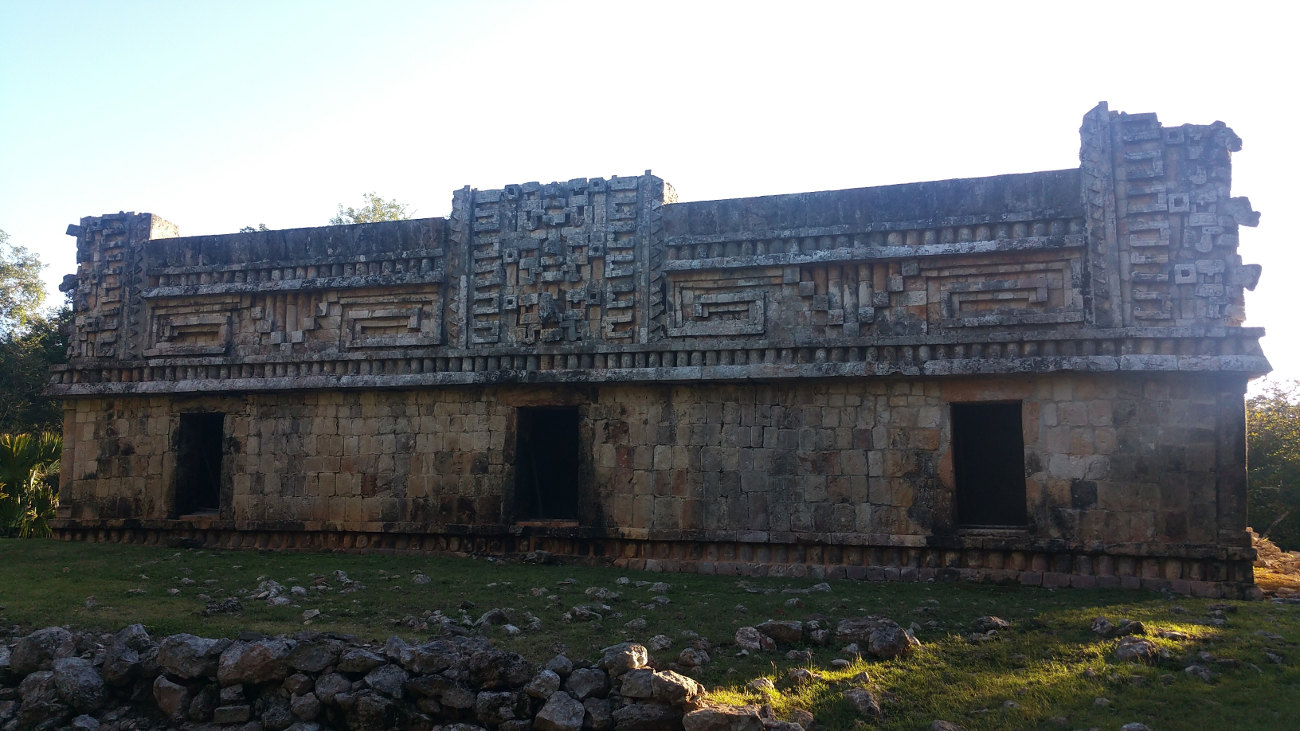 After just a few minutes of riding I arrived at the entrance to Xlapak. Here I was greeted by a much less friendly dog; he was barking at me before I got to within a hundred feet of the entrance. The attendant at the gate told me he was friendly so I cautiously walked past him to pay for my ticket. Strangely, this site had no charge. I asked if they were selling anything to drink and he showed me the cooler with a few bottles of water and some kind of strawberry soda.
After just a few minutes of riding I arrived at the entrance to Xlapak. Here I was greeted by a much less friendly dog; he was barking at me before I got to within a hundred feet of the entrance. The attendant at the gate told me he was friendly so I cautiously walked past him to pay for my ticket. Strangely, this site had no charge. I asked if they were selling anything to drink and he showed me the cooler with a few bottles of water and some kind of strawberry soda.  I never drink soda but thought I could use the energy and gave it a shot. It turned out to be pretty tasty, actually. I explored the largest temple on the premises. It had excellent detailed carvings in the roof and corners. I decided not to seek out the rest of the buildings since they weren't very close and I was worried about how much time I had. I ate another one of the mandarin oranges I had with me and paid for a second strawberry soda before taking off.
I never drink soda but thought I could use the energy and gave it a shot. It turned out to be pretty tasty, actually. I explored the largest temple on the premises. It had excellent detailed carvings in the roof and corners. I decided not to seek out the rest of the buildings since they weren't very close and I was worried about how much time I had. I ate another one of the mandarin oranges I had with me and paid for a second strawberry soda before taking off.
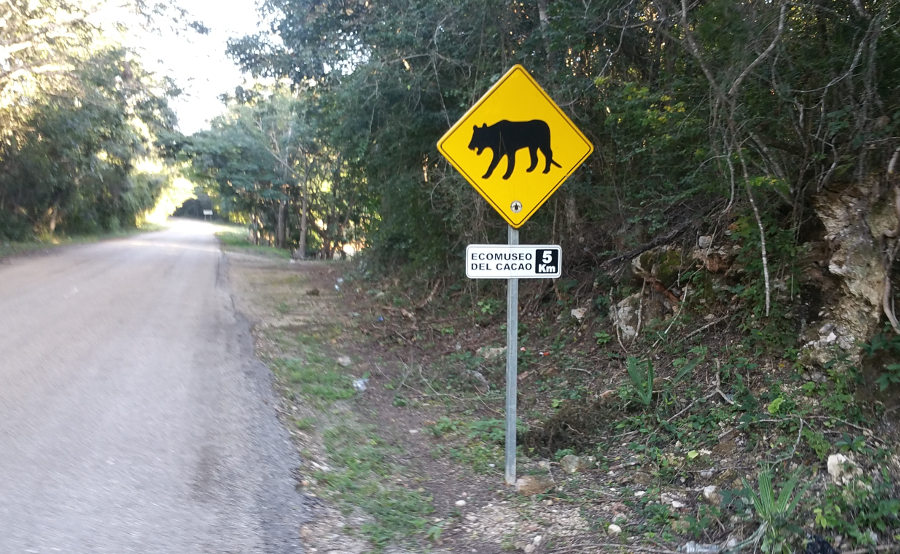 The last major site on the Ruuta Puuc that I was going to visit was Labna. I passed an interesting sign on the road and wasn't sure which part I should be paying more attention to... the cocoa museum up the road or the jaguars crossing. It occurred to me that this wouldn't be the best place in the world to run into mechanical issues. I saw no more than a handful cars on this road the whole time and most of them were parked. There were no restaurants, not even a shop as far as I could tell, oh and there might be jaguars. At least there's a cocoa museum...
The last major site on the Ruuta Puuc that I was going to visit was Labna. I passed an interesting sign on the road and wasn't sure which part I should be paying more attention to... the cocoa museum up the road or the jaguars crossing. It occurred to me that this wouldn't be the best place in the world to run into mechanical issues. I saw no more than a handful cars on this road the whole time and most of them were parked. There were no restaurants, not even a shop as far as I could tell, oh and there might be jaguars. At least there's a cocoa museum...
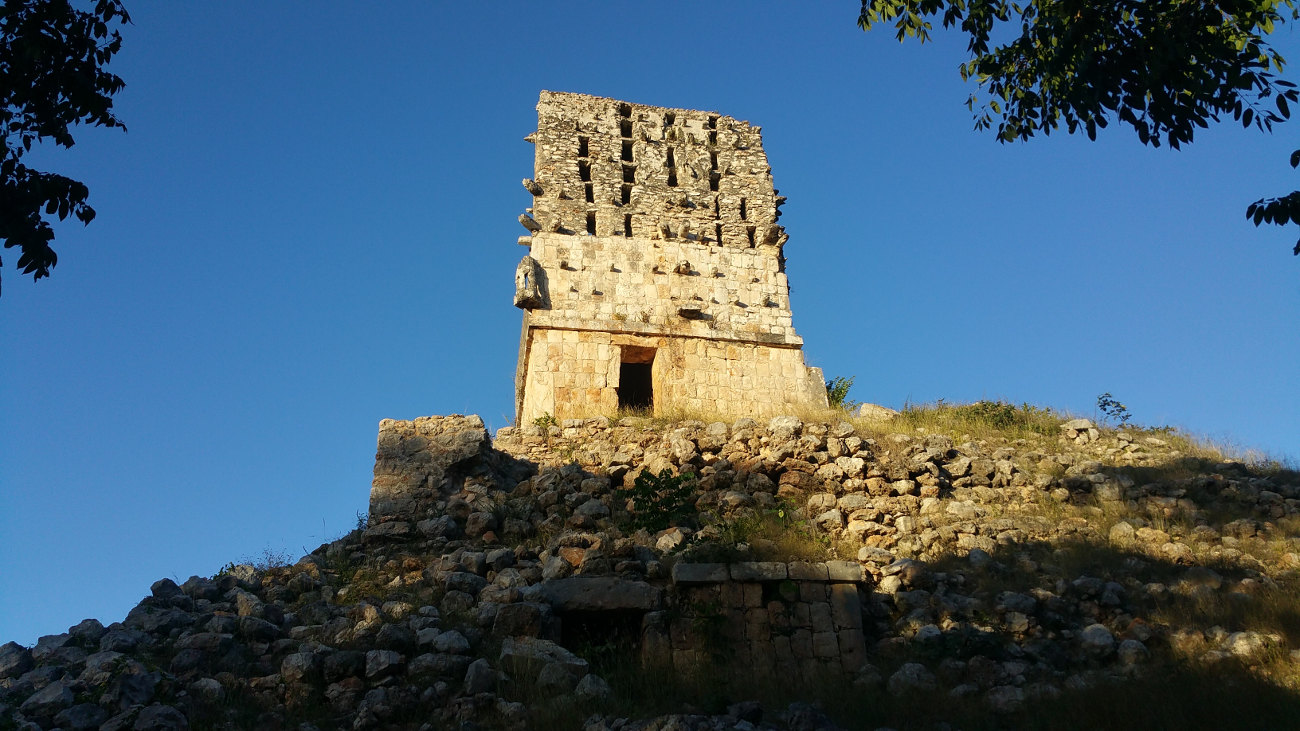 Labna was indeed the more impressive site. There was a large, heavily decorated temple with a prominent sacbe (Mayan elevated road) along with a few other structures in close proximity. It had a beautiful arch and haunting mirador temple on a partially excavated mount. Like the previous two sites there were very few other visitors. The late day sun was perfect for taking photos. I took a few then walked back to the bike.
Labna was indeed the more impressive site. There was a large, heavily decorated temple with a prominent sacbe (Mayan elevated road) along with a few other structures in close proximity. It had a beautiful arch and haunting mirador temple on a partially excavated mount. Like the previous two sites there were very few other visitors. The late day sun was perfect for taking photos. I took a few then walked back to the bike.
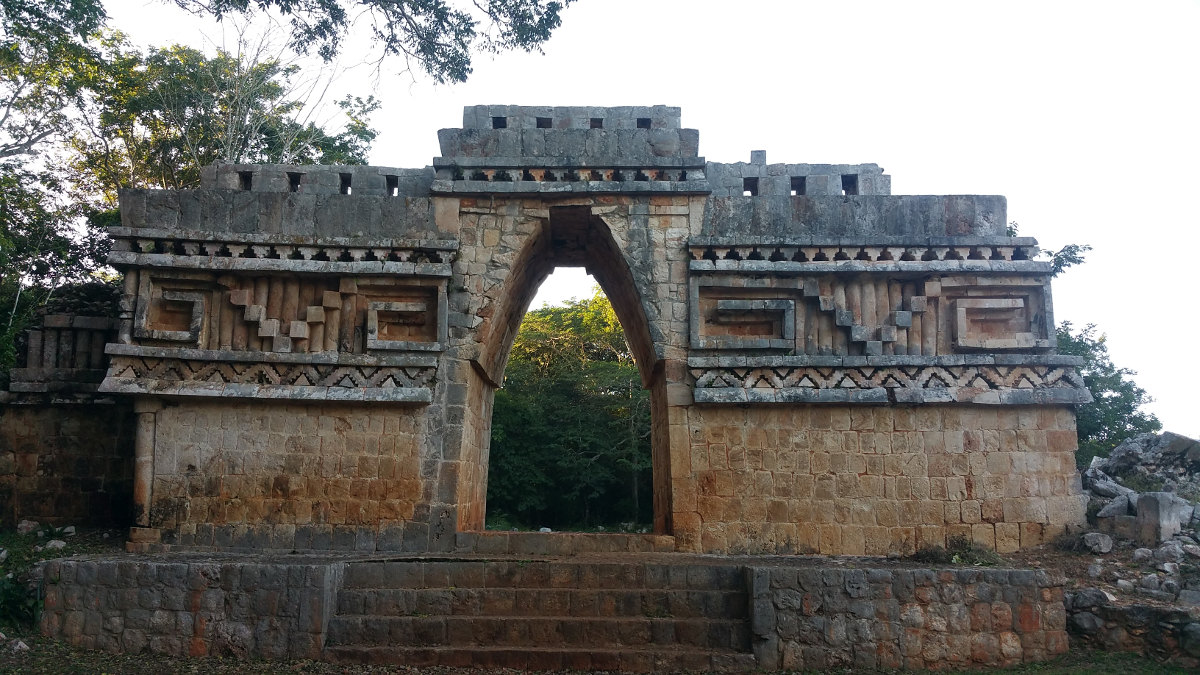 Looking at the time I didn't think I'd beat the sunset to where I was spending the night. I was hoping to at least have a little bit of the sun's glow by the end so I rode a little faster. I blazed past the cocoa museum, didn't even notice it. The area just east of the Puuc region is famous for it's citrus groves. I passed huge plantations of oranges and saw many trucks being loaded with cases of fresh fruit. There were a few tiny towns along the way but the area felt incredibly remote. I was forced to put my lights on in the last town on the way to my destination. Earlier I thought there'd be enough time to check out the famous cave system of Loltun but that was definitely not the case. I was later told the tour takes around 3 hours so there was really no way to squeeze that much into one day.
Looking at the time I didn't think I'd beat the sunset to where I was spending the night. I was hoping to at least have a little bit of the sun's glow by the end so I rode a little faster. I blazed past the cocoa museum, didn't even notice it. The area just east of the Puuc region is famous for it's citrus groves. I passed huge plantations of oranges and saw many trucks being loaded with cases of fresh fruit. There were a few tiny towns along the way but the area felt incredibly remote. I was forced to put my lights on in the last town on the way to my destination. Earlier I thought there'd be enough time to check out the famous cave system of Loltun but that was definitely not the case. I was later told the tour takes around 3 hours so there was really no way to squeeze that much into one day. 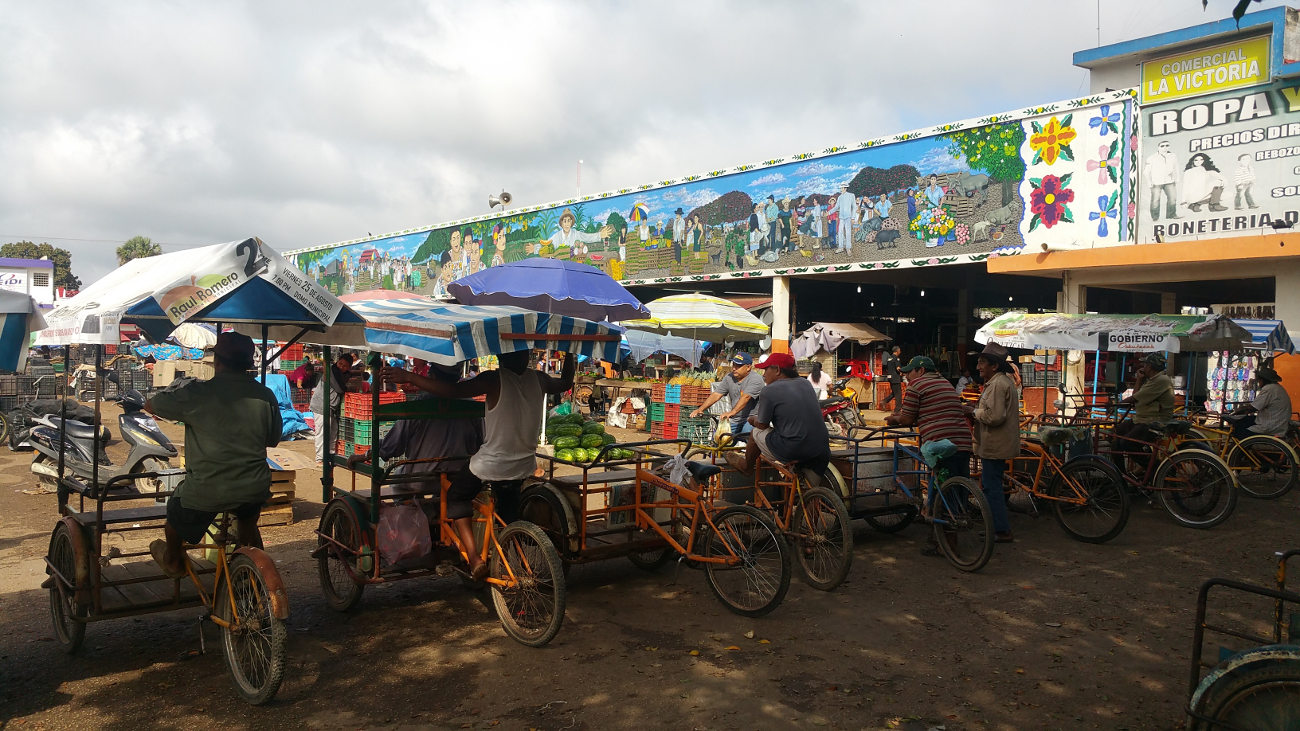 There was no light left for the last couple miles before I reached Oxcutzcab. The traffic was light but it was still uncomfortable to be riding at night on these small dark roads. I was passing some farm land when I heard a dog barking. As I got closer the dog started barking at me. When I passed him he started chasing and barking. I sprinted, heart in mouth, until I could tell he gave up. There was one big hill left before I got into town and I couldn't get over to the other side of it fast enough.
There was no light left for the last couple miles before I reached Oxcutzcab. The traffic was light but it was still uncomfortable to be riding at night on these small dark roads. I was passing some farm land when I heard a dog barking. As I got closer the dog started barking at me. When I passed him he started chasing and barking. I sprinted, heart in mouth, until I could tell he gave up. There was one big hill left before I got into town and I couldn't get over to the other side of it fast enough.
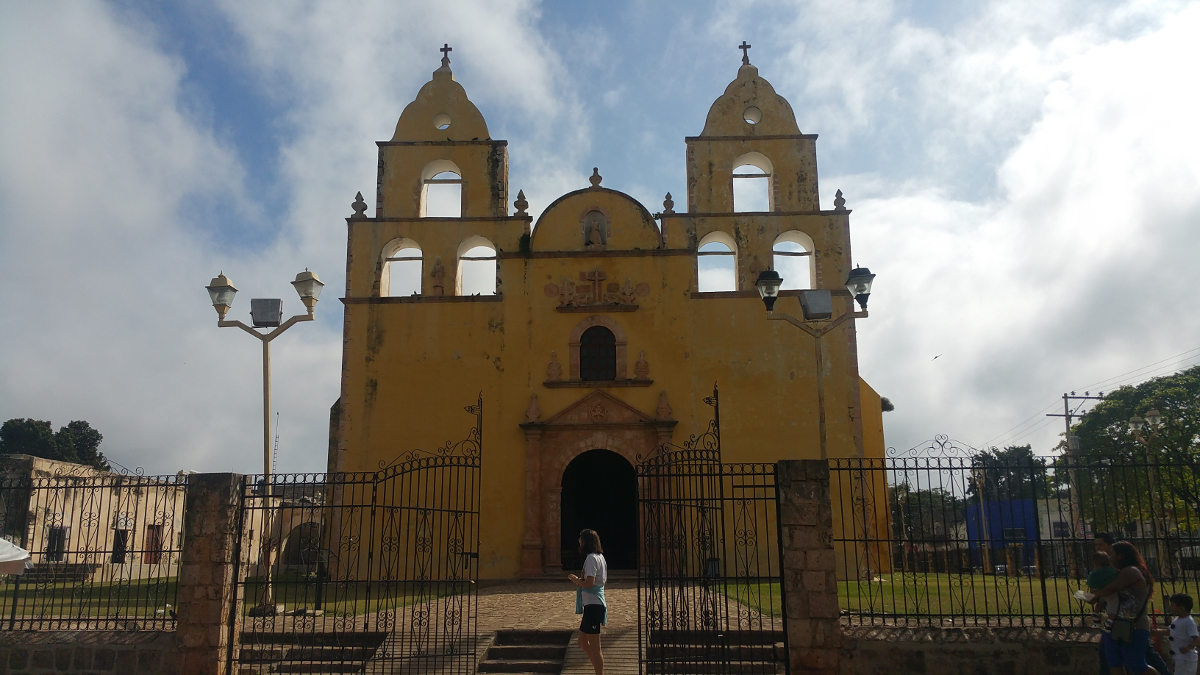 Gina got us rooms in one of the more popular hotels in Oxcutzcab and I was happy to settle in. She needed a bit more rest so I went in search of food by myself. I asked a local gentleman where to go and he quickly switched to English. He told me he lived in California for several years over the course of two stints. Apparently around 20% of Oxcutzcab was working north of the border and sending remitances back down. His English was excellent and he told me it helped to have native speakers correct you when you make mistakes.
Gina got us rooms in one of the more popular hotels in Oxcutzcab and I was happy to settle in. She needed a bit more rest so I went in search of food by myself. I asked a local gentleman where to go and he quickly switched to English. He told me he lived in California for several years over the course of two stints. Apparently around 20% of Oxcutzcab was working north of the border and sending remitances back down. His English was excellent and he told me it helped to have native speakers correct you when you make mistakes. 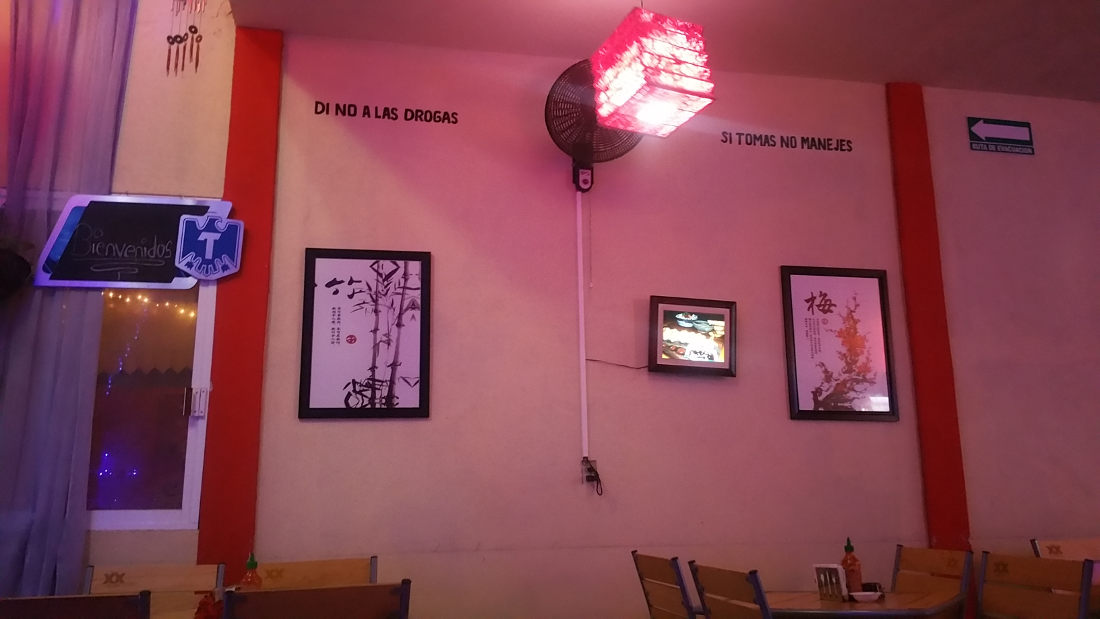 He corrected every one of my Spanish sentences when we switched languages. The restaurant he suggested served mosty Asian food and there were bottles of Sriracha at every table. I went with the most Mexican thing on the menu though and ordered some nachos with a bottle of Bohemia clara. It was a satisfying end to the day and I slept really well that night.
He corrected every one of my Spanish sentences when we switched languages. The restaurant he suggested served mosty Asian food and there were bottles of Sriracha at every table. I went with the most Mexican thing on the menu though and ordered some nachos with a bottle of Bohemia clara. It was a satisfying end to the day and I slept really well that night.
Day 3— Tixcacaltuyub to Piste — 33 miles
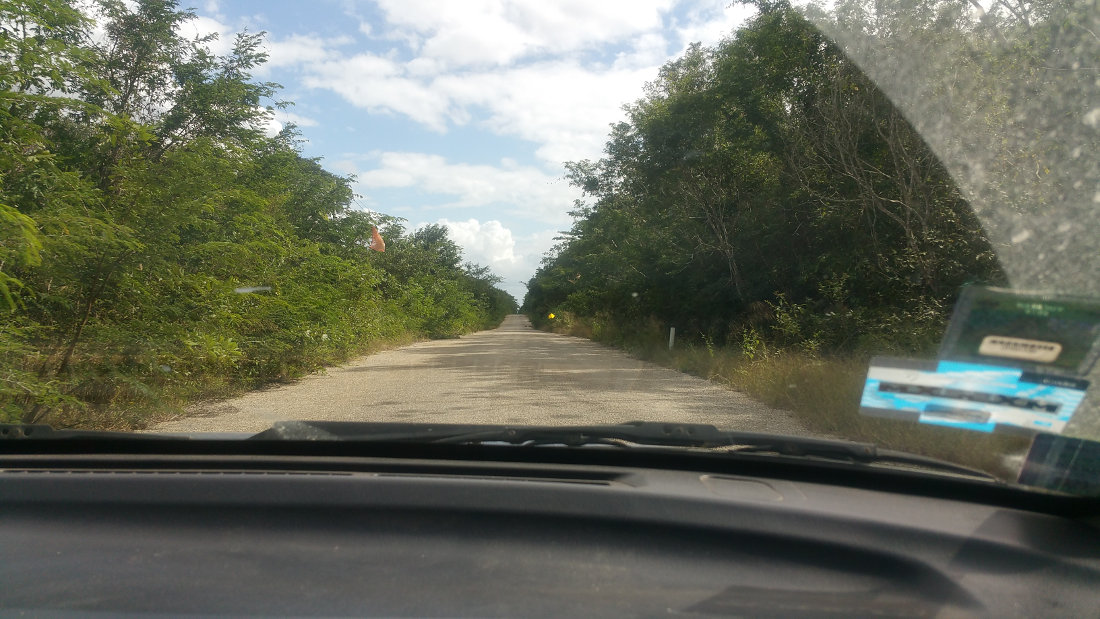 We decided to adjust the itinerary for our third day of riding. The original plan was to ride to Peto for the night and then ride to Piste the next day. The latter ride was supposed to be lovely but I didn't have much planned for the ride to Peto or for the town itself. Instead we decided to combine the next two days into one but it was a bit too much distance to ride so we sought out a taxi driver to take us part of the way. This would allow us to ride the bulk of the Peto-Piste section and get to Valladolid faster. We decided to start in a town called Sisbic. After a bit of negotiating we loaded our bikes into the trunk of Jorge's (another Yucatecan gentleman who lived in the States in the past and spoke excellent English) tiny 80's taxi and set off on the road. Jorge pointed out a small, fenced off Mayan pyramid at the side of the road as we drove be. I felt like we were surrounded by history everywhere we went. Sisbic didn't seem to exist where it was supposed to be on the map so we got dropped off in the next town, Tixcacaltuyub (probably my favorite Mayan town name to pronounce).
We decided to adjust the itinerary for our third day of riding. The original plan was to ride to Peto for the night and then ride to Piste the next day. The latter ride was supposed to be lovely but I didn't have much planned for the ride to Peto or for the town itself. Instead we decided to combine the next two days into one but it was a bit too much distance to ride so we sought out a taxi driver to take us part of the way. This would allow us to ride the bulk of the Peto-Piste section and get to Valladolid faster. We decided to start in a town called Sisbic. After a bit of negotiating we loaded our bikes into the trunk of Jorge's (another Yucatecan gentleman who lived in the States in the past and spoke excellent English) tiny 80's taxi and set off on the road. Jorge pointed out a small, fenced off Mayan pyramid at the side of the road as we drove be. I felt like we were surrounded by history everywhere we went. Sisbic didn't seem to exist where it was supposed to be on the map so we got dropped off in the next town, Tixcacaltuyub (probably my favorite Mayan town name to pronounce).
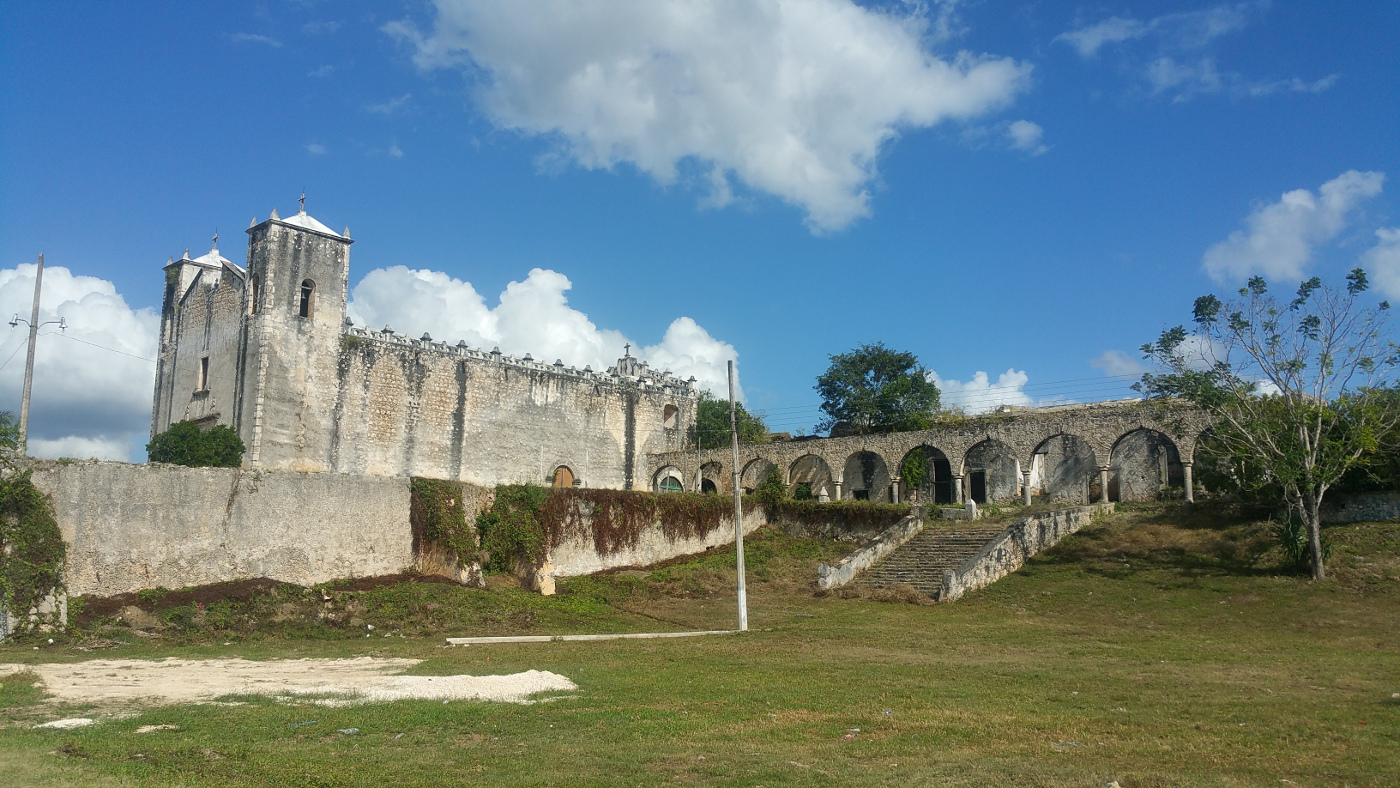 Tixcacaltuyub was a charming little town with a stone-colored church and a few other colonial remains. It was a lovely and peaceful place to start the ride. I used the bathroom in an old cantina and ran into Jorge who decided to have a drink before driving the 70km or so back to Oxcutzcab. We took a bunch of photos and kept riding towards Piste.
Tixcacaltuyub was a charming little town with a stone-colored church and a few other colonial remains. It was a lovely and peaceful place to start the ride. I used the bathroom in an old cantina and ran into Jorge who decided to have a drink before driving the 70km or so back to Oxcutzcab. We took a bunch of photos and kept riding towards Piste.
 Next on the list was Yaxcaba. It was another peaceful tiny town with a beautiful red church in the center. This area definitely does not see very many visitors. The roads are small and they don't connect too many of the major attractions of the area. There was a really interesting stone arch at the side of the road. I wondered if it was part of something ancient. We rode into Kancabdzonot, an even smaller village two towns away from Piste.
Next on the list was Yaxcaba. It was another peaceful tiny town with a beautiful red church in the center. This area definitely does not see very many visitors. The roads are small and they don't connect too many of the major attractions of the area. There was a really interesting stone arch at the side of the road. I wondered if it was part of something ancient. We rode into Kancabdzonot, an even smaller village two towns away from Piste. 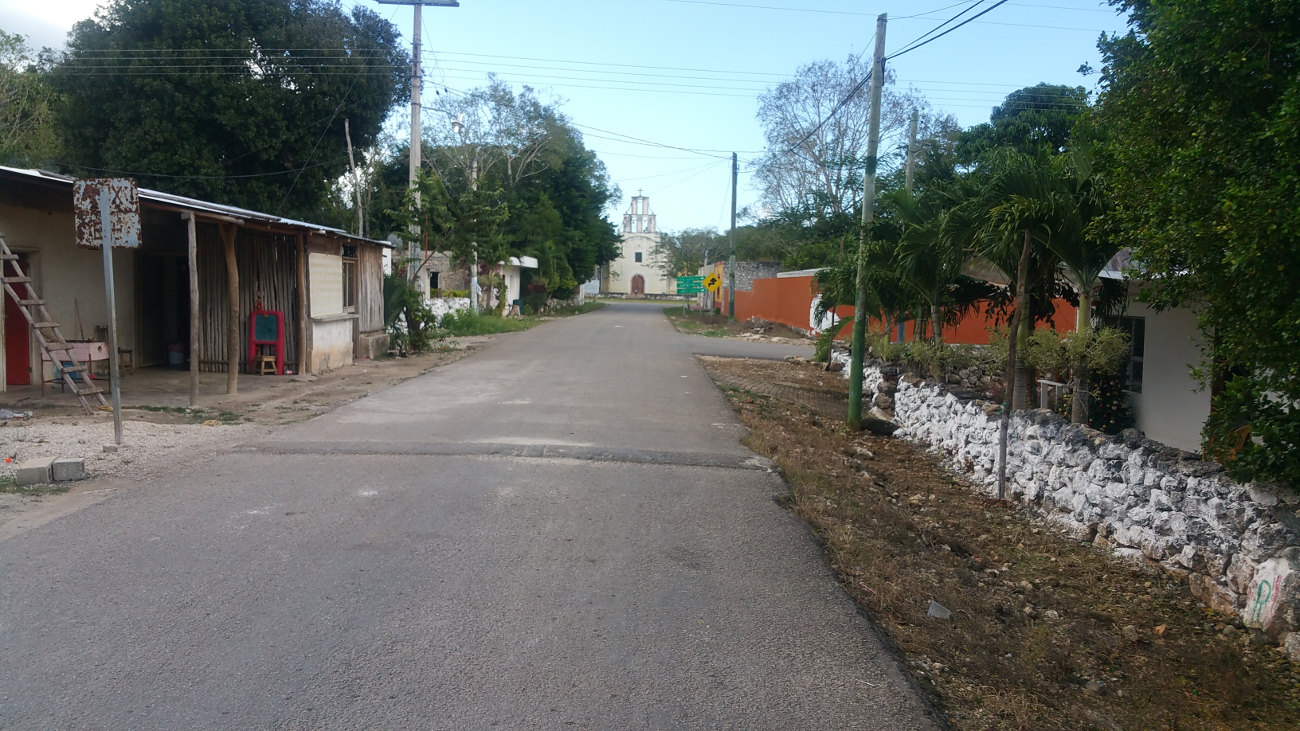 A bunch of kids were practicing their English with me as I stopped into a store in the center of town to buy a couple sodas. I guess showing up in a helmet, cycling jersey, and jean shorts in a tiny village makes you look like an Anglophone foreigner for some reason. After taking a breather and trying but failing to look up where the nearest cenote was due to poor cell signal we rode on to Yaxuna.
A bunch of kids were practicing their English with me as I stopped into a store in the center of town to buy a couple sodas. I guess showing up in a helmet, cycling jersey, and jean shorts in a tiny village makes you look like an Anglophone foreigner for some reason. After taking a breather and trying but failing to look up where the nearest cenote was due to poor cell signal we rode on to Yaxuna.
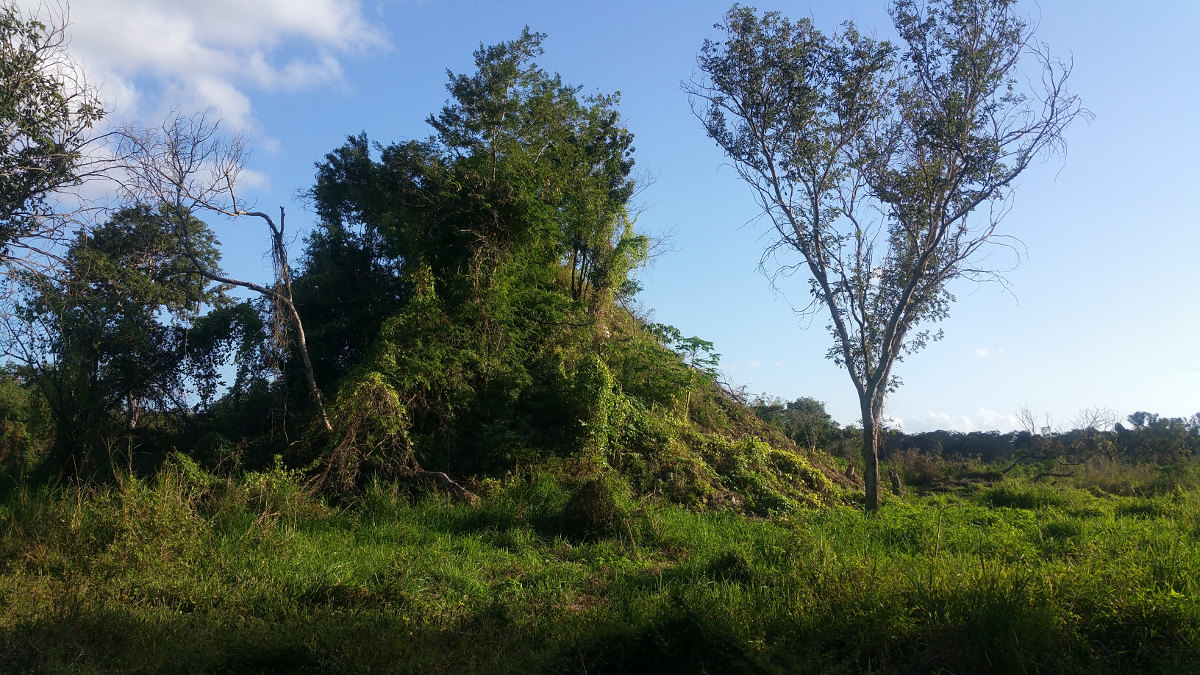 Yaxuna was a town of barely any streets so we rode through it kind of quickly. Just north of town was the archeological zone of the same name that I recalled Jorge mentioning while we were driving. We rode our bikes right through the site. It was a smaller one with a handful of excavated structures. There were a few overgrown mounds in the area which most likely contain additional structures that require work to exhume. We kept riding, hoping to run into the cenote I expected we would pass any minute now. We asked around at the next roadside village but it seemed as though we missed it. I later learned we passed one street away from it right inside Yaxuna. Bummer. We were determined to get to Piste before sunset so we kept riding, passing a goat herder on the road, the remaining few miles.
Yaxuna was a town of barely any streets so we rode through it kind of quickly. Just north of town was the archeological zone of the same name that I recalled Jorge mentioning while we were driving. We rode our bikes right through the site. It was a smaller one with a handful of excavated structures. There were a few overgrown mounds in the area which most likely contain additional structures that require work to exhume. We kept riding, hoping to run into the cenote I expected we would pass any minute now. We asked around at the next roadside village but it seemed as though we missed it. I later learned we passed one street away from it right inside Yaxuna. Bummer. We were determined to get to Piste before sunset so we kept riding, passing a goat herder on the road, the remaining few miles.
 Our mission to avoid riding at night was successful on the third try. We arrived in the center of Piste right at dusk and were greeted by a parade of marching children dressed as santas and elves. We settled into a hotel and went to a restaurant inside a palapa across the street for some gilled chicken. I walked around town a little bit after dinner. Piste is totally different from the towns we passed earlier in the day. For a small town, Piste had a large number of hotels. Some were very modern looking and were pretty expensive. Almost every store in town was selling nearly identical Mayan-themed trinkets and souvenirs. There were tourists speaking a variety of different languages walking around the streets. The reason was obvious; the ruins of Chichen Itza, one of the most popular destinations on the whole peninsula, were barely a mile outside of town. The best way to beat the crowds was to stay nearby and get in first thing in the morning. Probably everyone spending the night here had that exact idea in mind.
Our mission to avoid riding at night was successful on the third try. We arrived in the center of Piste right at dusk and were greeted by a parade of marching children dressed as santas and elves. We settled into a hotel and went to a restaurant inside a palapa across the street for some gilled chicken. I walked around town a little bit after dinner. Piste is totally different from the towns we passed earlier in the day. For a small town, Piste had a large number of hotels. Some were very modern looking and were pretty expensive. Almost every store in town was selling nearly identical Mayan-themed trinkets and souvenirs. There were tourists speaking a variety of different languages walking around the streets. The reason was obvious; the ruins of Chichen Itza, one of the most popular destinations on the whole peninsula, were barely a mile outside of town. The best way to beat the crowds was to stay nearby and get in first thing in the morning. Probably everyone spending the night here had that exact idea in mind.
Day 4 — Piste to Valladolid — 31 miles
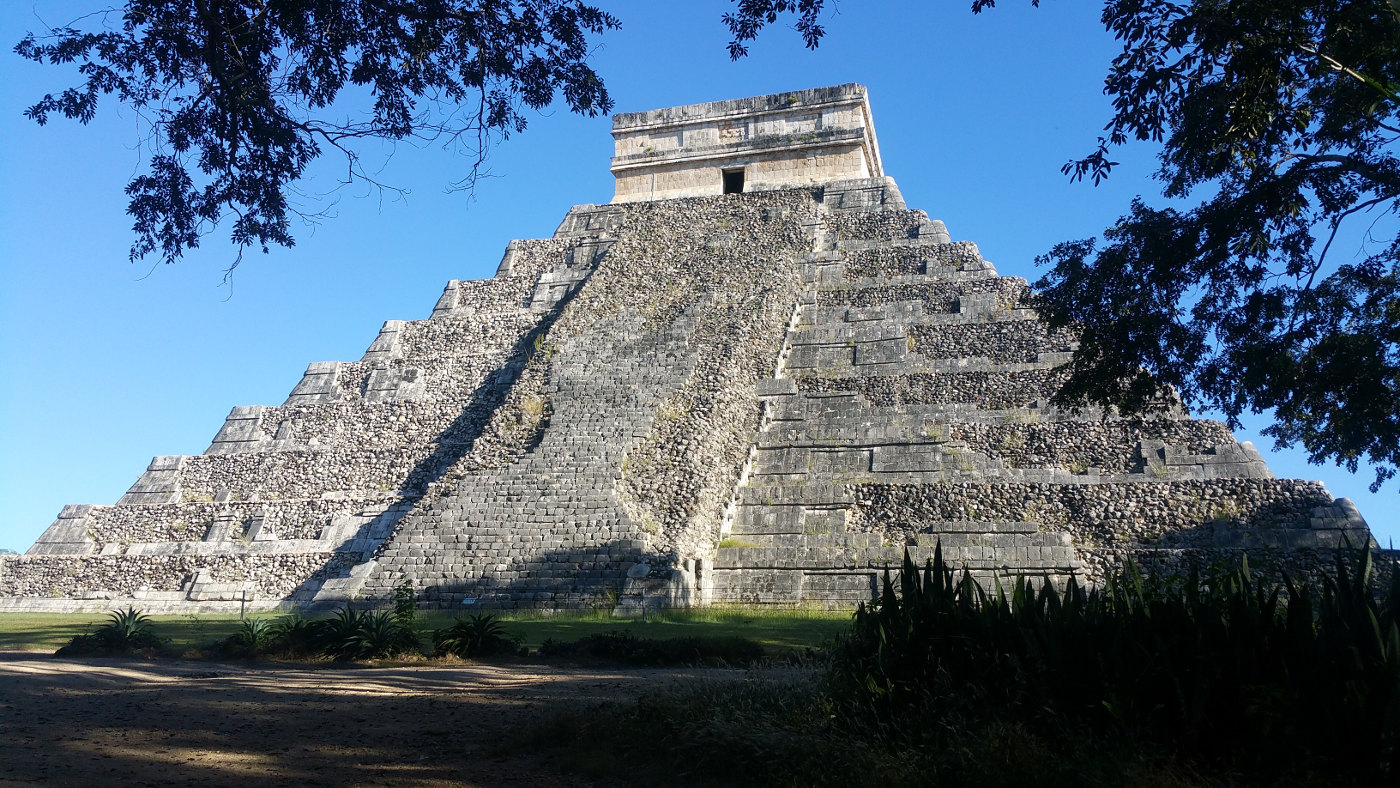 Biking to the ruins was the best possible idea. We arrived about 15 minutes after the ruins opened and there was already a line of cars trying to get into the main parking lot. A few groups of people were walking in. Gina and I simply rode past everyone, locked up our bikes and got our tickets. There were a few small clusters of people already inside but the place wasn't crowded. Dozens of vendors selling t-shirts and souvenirs were setting up their tables along the walkways between structures. Our peace was constantly disturbed by vendors showing off their jaguar noise making whistle things. The most iconic pyramid, el Castillo, was a majestic sight to see in person.
Biking to the ruins was the best possible idea. We arrived about 15 minutes after the ruins opened and there was already a line of cars trying to get into the main parking lot. A few groups of people were walking in. Gina and I simply rode past everyone, locked up our bikes and got our tickets. There were a few small clusters of people already inside but the place wasn't crowded. Dozens of vendors selling t-shirts and souvenirs were setting up their tables along the walkways between structures. Our peace was constantly disturbed by vendors showing off their jaguar noise making whistle things. The most iconic pyramid, el Castillo, was a majestic sight to see in person. 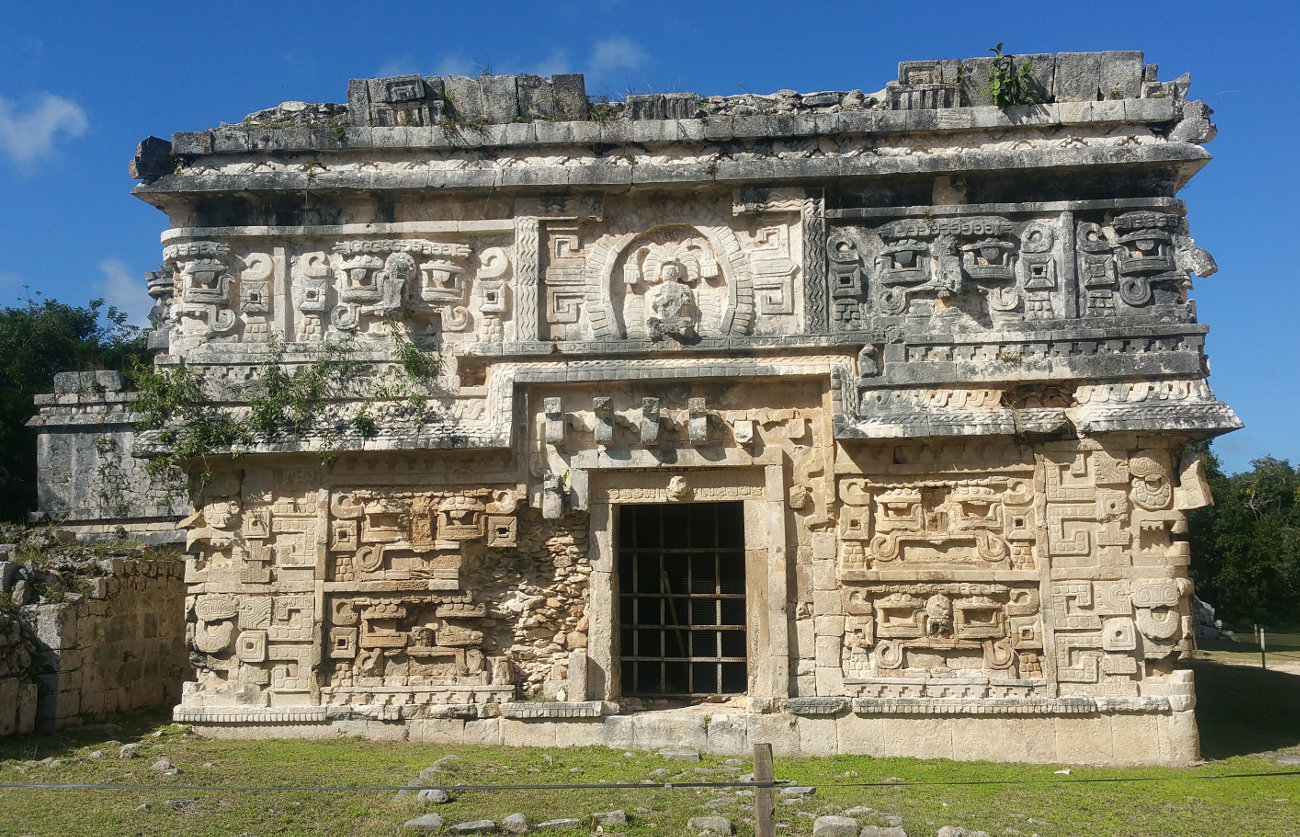 Elsewhere around the site there were over a dozen well preserved structures that would be impressive all on their own. There were a couple of Puuc-style buildings, a huge observatory with a round dome and several shorter pyramids. The ball court was by far the largest I've ever seen, larger than a football field.
Elsewhere around the site there were over a dozen well preserved structures that would be impressive all on their own. There were a couple of Puuc-style buildings, a huge observatory with a round dome and several shorter pyramids. The ball court was by far the largest I've ever seen, larger than a football field. 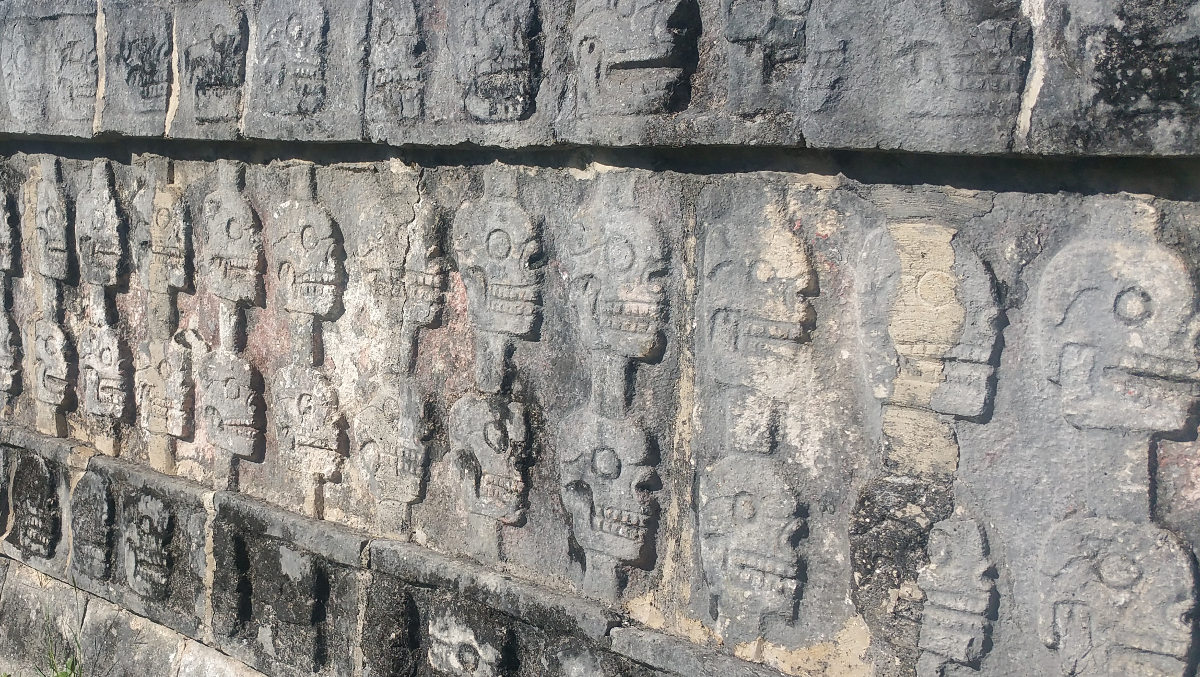 The rings were so high up I couldn't imagine someone kicking a ball through them. Many of the carvings were very well preserved. Some highlights included a huge length of skulls and a jaguar eating a human heart. I heard guides speaking English, German and Russian in addition to Spanish. There were lizards running around the site as I've seen in several others but I was surprised to encounter a small brown squirrel chewing on something in a patch of shrubs. The sun was really heating up by the late morning. On our way out we saw literally hundreds of people making their way in, many dressed the same so as not to get lost. We were relieved to have gotten in and out before the hordes arrived.
The rings were so high up I couldn't imagine someone kicking a ball through them. Many of the carvings were very well preserved. Some highlights included a huge length of skulls and a jaguar eating a human heart. I heard guides speaking English, German and Russian in addition to Spanish. There were lizards running around the site as I've seen in several others but I was surprised to encounter a small brown squirrel chewing on something in a patch of shrubs. The sun was really heating up by the late morning. On our way out we saw literally hundreds of people making their way in, many dressed the same so as not to get lost. We were relieved to have gotten in and out before the hordes arrived.
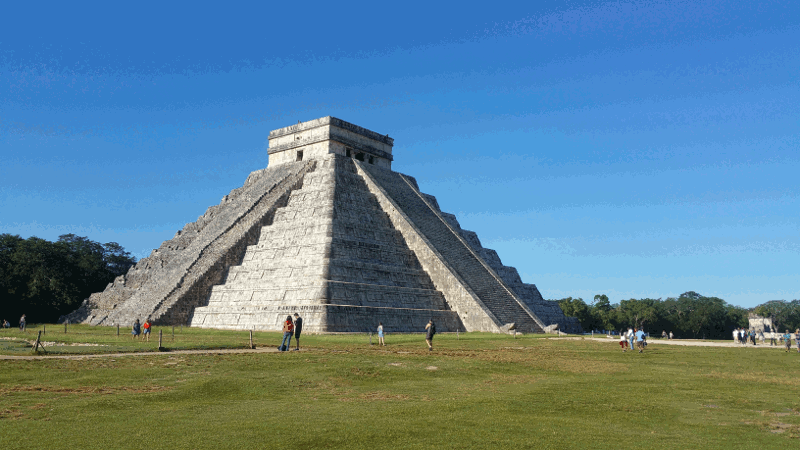 We had lunch in a place I spotted the day before that was decorated like an old hacienda. It turned out to be a buffet catering to huge tour bus groups and had people dressed in traditional garb performing gaudy dance routines for tips. Definitely not the experience I was looking for but at least the food was decent. Gina needed to get her bike prepared for her trip back the next day so she arranged for a cab to take her to Valladolid. I was going to ride and meet her there. We checked out a little later than we said we would and I got on the road, riding past the seemingly infinite line of cars still trying to get into Chichen Itza.
We had lunch in a place I spotted the day before that was decorated like an old hacienda. It turned out to be a buffet catering to huge tour bus groups and had people dressed in traditional garb performing gaudy dance routines for tips. Definitely not the experience I was looking for but at least the food was decent. Gina needed to get her bike prepared for her trip back the next day so she arranged for a cab to take her to Valladolid. I was going to ride and meet her there. We checked out a little later than we said we would and I got on the road, riding past the seemingly infinite line of cars still trying to get into Chichen Itza.
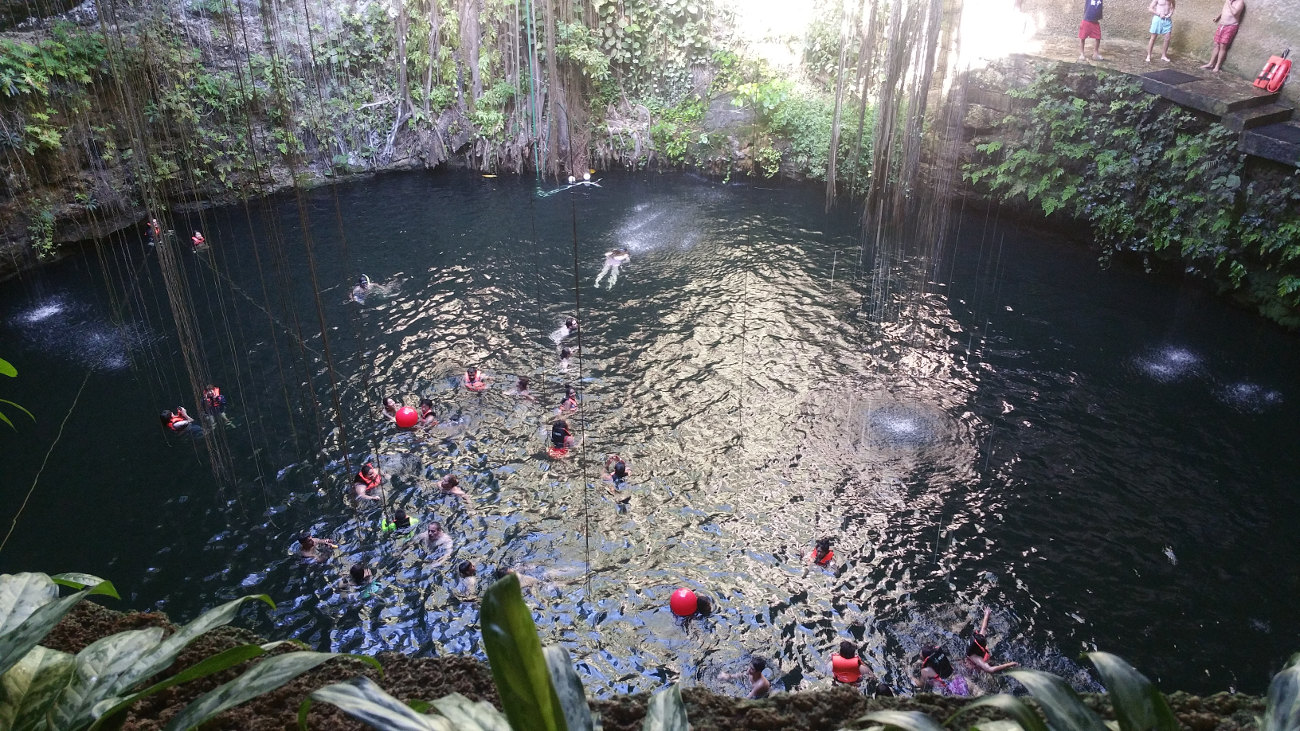 The part of the Yucatan I was now in had a huge concentration of what makes the peninsula so special. There are colonial towns, several famous Mayan ruins, and innumerable cenotes. Cenotes are ancient freshwater sinkholes that form as a result of limestone dissolving from rain water. The Yucatan has thousands of cenotes of many different shapes and sizes sprinkled along an arc across the peninsula and I was right in the middle of this arc. Some cenotes are completely open and look like a pond. Others are totally concealed and cave-like with only artificial light. Both are charactized by crystal clear water with dozens of feet of visibility. The water is actually an underground river which unlike a stagnant pond is constantly flowing and purifying itself. Small fish swim around and if you sit still might peck at your feet. I was hoping to spend a lot of time exploring cenotes during this portion of the trip. One of the most famous ones, Ik-Kil happens to be on the road between Chichen Itza and Valladolid. Many bus tours stop there after the ruins and the place was starting to get crowded when I rode in.
The part of the Yucatan I was now in had a huge concentration of what makes the peninsula so special. There are colonial towns, several famous Mayan ruins, and innumerable cenotes. Cenotes are ancient freshwater sinkholes that form as a result of limestone dissolving from rain water. The Yucatan has thousands of cenotes of many different shapes and sizes sprinkled along an arc across the peninsula and I was right in the middle of this arc. Some cenotes are completely open and look like a pond. Others are totally concealed and cave-like with only artificial light. Both are charactized by crystal clear water with dozens of feet of visibility. The water is actually an underground river which unlike a stagnant pond is constantly flowing and purifying itself. Small fish swim around and if you sit still might peck at your feet. I was hoping to spend a lot of time exploring cenotes during this portion of the trip. One of the most famous ones, Ik-Kil happens to be on the road between Chichen Itza and Valladolid. Many bus tours stop there after the ruins and the place was starting to get crowded when I rode in.  The cenote requires a quick rinse to keep the water clean considering how many sunscreen-lathered tourists jump in on a daily basis. The water felt wonderful considering the temperature was probably in the 90's in the sun. There was at least one full bus of tourists in the water with a few more about to get in. I kept it short and sweet. I hung my swim shorts from my saddle to dry while I rode and continued on highway 180 heading east.
The cenote requires a quick rinse to keep the water clean considering how many sunscreen-lathered tourists jump in on a daily basis. The water felt wonderful considering the temperature was probably in the 90's in the sun. There was at least one full bus of tourists in the water with a few more about to get in. I kept it short and sweet. I hung my swim shorts from my saddle to dry while I rode and continued on highway 180 heading east.
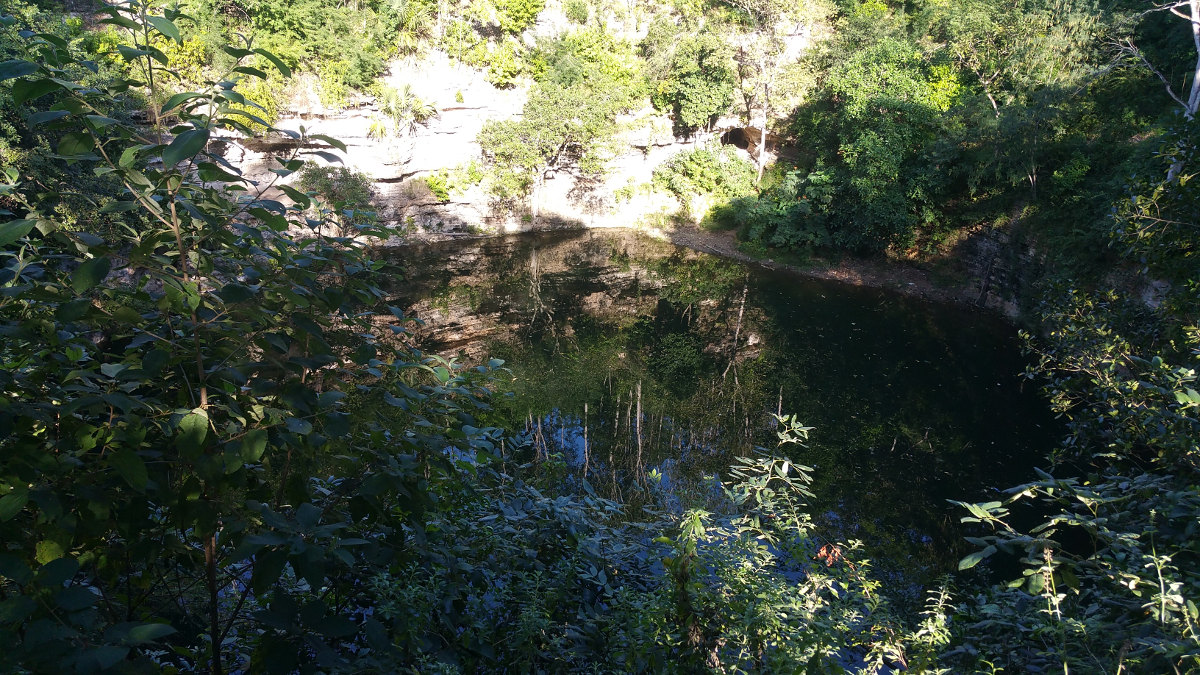 The road I was on was almost the complete opposite of the country roads I rode the day before. Even though there were not many cars it was much busier than the small roads have been thus far. A huge portion of the traffic was tour buses going to and from the ruins. The road had a shoulder so the ride was totally comfortable but kind of boring. The towns I passed, being on the bus route, were full of tourist shops and little else. I found a paved lane that seemed to come out of nowhere in the brush next to the road and got on it. It ended up taking me into a town and I decided to stop for lunch. The town, Kaua, had a cenote in it and I went to check it out. Unlike Ik-Kil, this one seemed to have pretty murky water and wasn't conducive for swimming. The wooden path getting down to the water didn't even make it half way down so I turned around and looked for a place to eat. Several people tried to get me to go to the restaurant they were representing and the most persuasive salespeople were a couple of children around 5 years old so I went where they told me. Of the 5 restaurants in town, 4 of them were the tio/tia (uncle/aunt) of something. I had the house specialty, poc chuc (grilled pork), which I thoroughly enjoyed. I drank yet another couple sodas and kept riding.
The road I was on was almost the complete opposite of the country roads I rode the day before. Even though there were not many cars it was much busier than the small roads have been thus far. A huge portion of the traffic was tour buses going to and from the ruins. The road had a shoulder so the ride was totally comfortable but kind of boring. The towns I passed, being on the bus route, were full of tourist shops and little else. I found a paved lane that seemed to come out of nowhere in the brush next to the road and got on it. It ended up taking me into a town and I decided to stop for lunch. The town, Kaua, had a cenote in it and I went to check it out. Unlike Ik-Kil, this one seemed to have pretty murky water and wasn't conducive for swimming. The wooden path getting down to the water didn't even make it half way down so I turned around and looked for a place to eat. Several people tried to get me to go to the restaurant they were representing and the most persuasive salespeople were a couple of children around 5 years old so I went where they told me. Of the 5 restaurants in town, 4 of them were the tio/tia (uncle/aunt) of something. I had the house specialty, poc chuc (grilled pork), which I thoroughly enjoyed. I drank yet another couple sodas and kept riding.
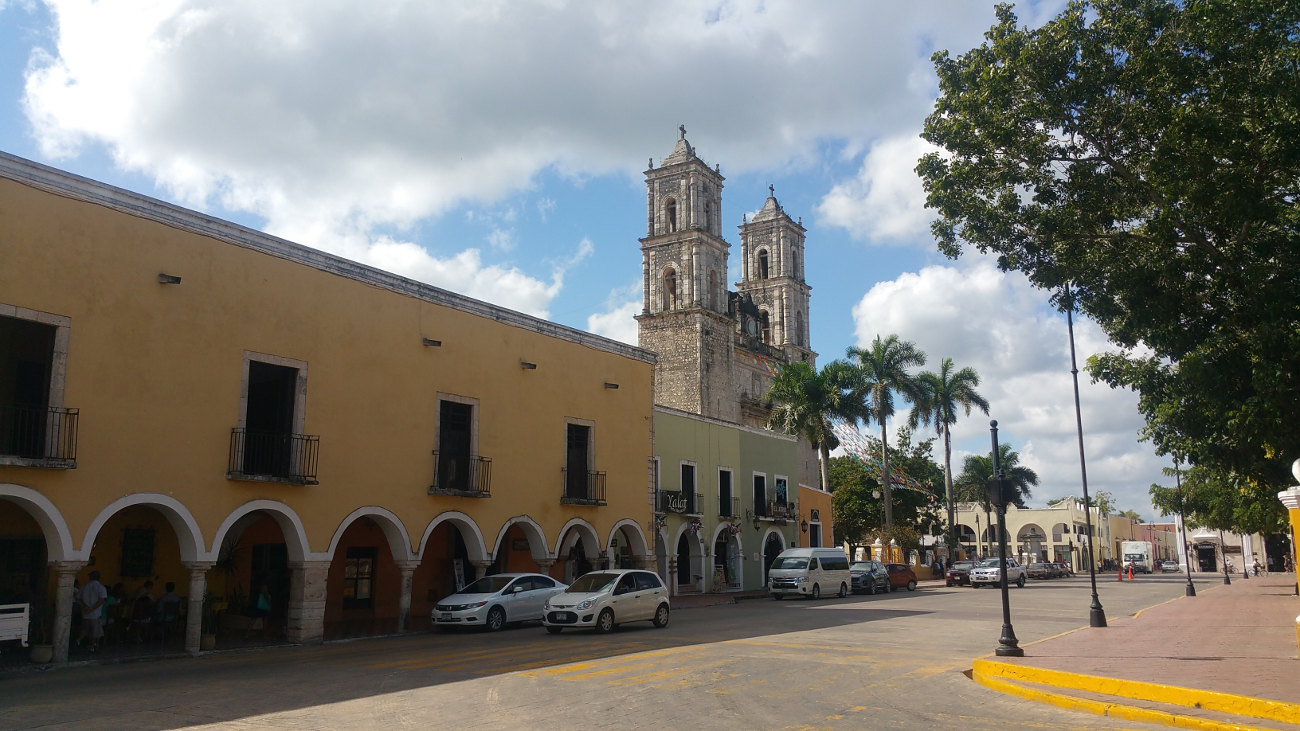 After spending the night in sleepy towns several nights in a row I was stoked to be rolling into a larger city, Valladolid, right before sunset. There were many tour buses in and around the center along with many more tourists than I remebered seeing the last time I was here. I looked around for a place with WiFi to connect with Gina and settled on the spacious outdoor restaurant connected to cenote Zaci, a large open air cenote located conveniently right in the center of town. Gina still had a few things to take care of to get her bike packed for her trip so we toiled around town while the stores were still open. Dinner was at one of the fancier places in the Sisal neighborhood right next to a famous convent.
After spending the night in sleepy towns several nights in a row I was stoked to be rolling into a larger city, Valladolid, right before sunset. There were many tour buses in and around the center along with many more tourists than I remebered seeing the last time I was here. I looked around for a place with WiFi to connect with Gina and settled on the spacious outdoor restaurant connected to cenote Zaci, a large open air cenote located conveniently right in the center of town. Gina still had a few things to take care of to get her bike packed for her trip so we toiled around town while the stores were still open. Dinner was at one of the fancier places in the Sisal neighborhood right next to a famous convent.  We left satisfied and noticed a crowd right in front of the convent. A video was being projected on its walls by four giant projectors. The video was perfectly tailored to the specific shape of the convent and was incredibly engaging. I told the history of the area and the role Valladolid played in it. I was puzzled as to why it was in English but was thorougly impressed. I helped Gina get ready to for her trip the next morning and decided I'd keep the same room another night.
We left satisfied and noticed a crowd right in front of the convent. A video was being projected on its walls by four giant projectors. The video was perfectly tailored to the specific shape of the convent and was incredibly engaging. I told the history of the area and the role Valladolid played in it. I was puzzled as to why it was in English but was thorougly impressed. I helped Gina get ready to for her trip the next morning and decided I'd keep the same room another night.
Day 5 — Valladolid to Valladolid — 6 miles
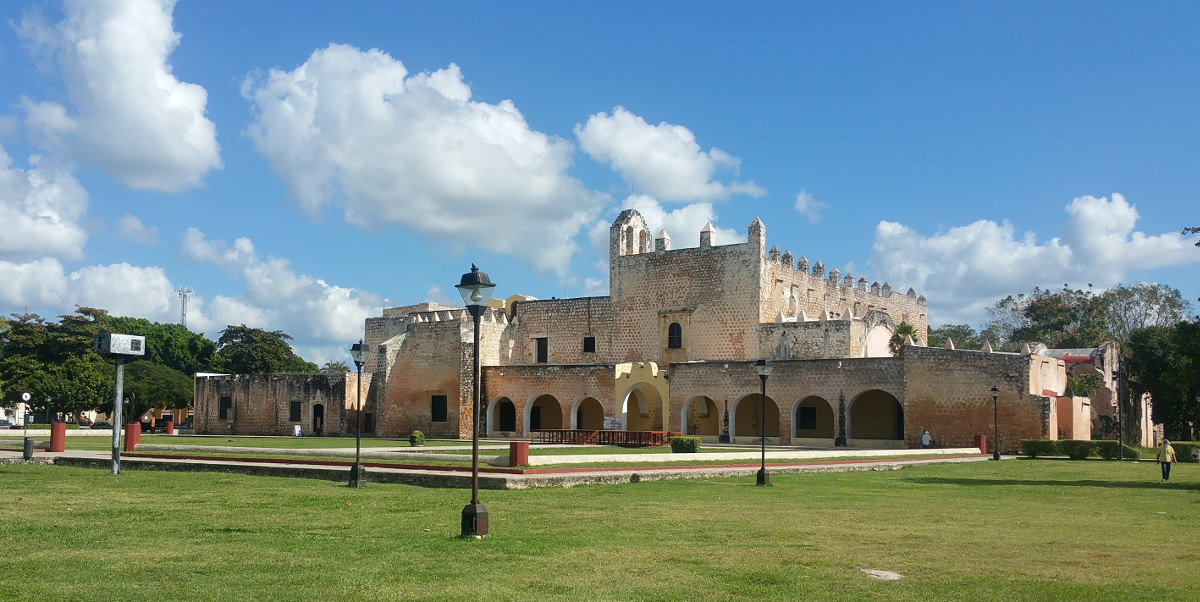 The beauty of adjusting our trip a couple days earlier was that it bought me a rest day in the middle of the ride. Valladolid was the perfect place to spend that extra day because it's a larger town and because of all the attractions nearby. Though it seemed much less lively and engaging to me on my previous visit two years prior, I was much more enthusiastic about it the second time around. I considered vising Cenotillo, a town full of cenotes, or the nearby ruins of Ek-Balam but decided to stay more local. I chose to go to a cenote located at an old Hacienda barely two miles from where I was staying. The ride was short and the hacienda was beautiful. The cenote had the most incredibly pure blue water. There were few people swimming. There was a couple from California, another from Canada, two Mexican women, and a handful of others would come and go during my time.
The beauty of adjusting our trip a couple days earlier was that it bought me a rest day in the middle of the ride. Valladolid was the perfect place to spend that extra day because it's a larger town and because of all the attractions nearby. Though it seemed much less lively and engaging to me on my previous visit two years prior, I was much more enthusiastic about it the second time around. I considered vising Cenotillo, a town full of cenotes, or the nearby ruins of Ek-Balam but decided to stay more local. I chose to go to a cenote located at an old Hacienda barely two miles from where I was staying. The ride was short and the hacienda was beautiful. The cenote had the most incredibly pure blue water. There were few people swimming. There was a couple from California, another from Canada, two Mexican women, and a handful of others would come and go during my time. 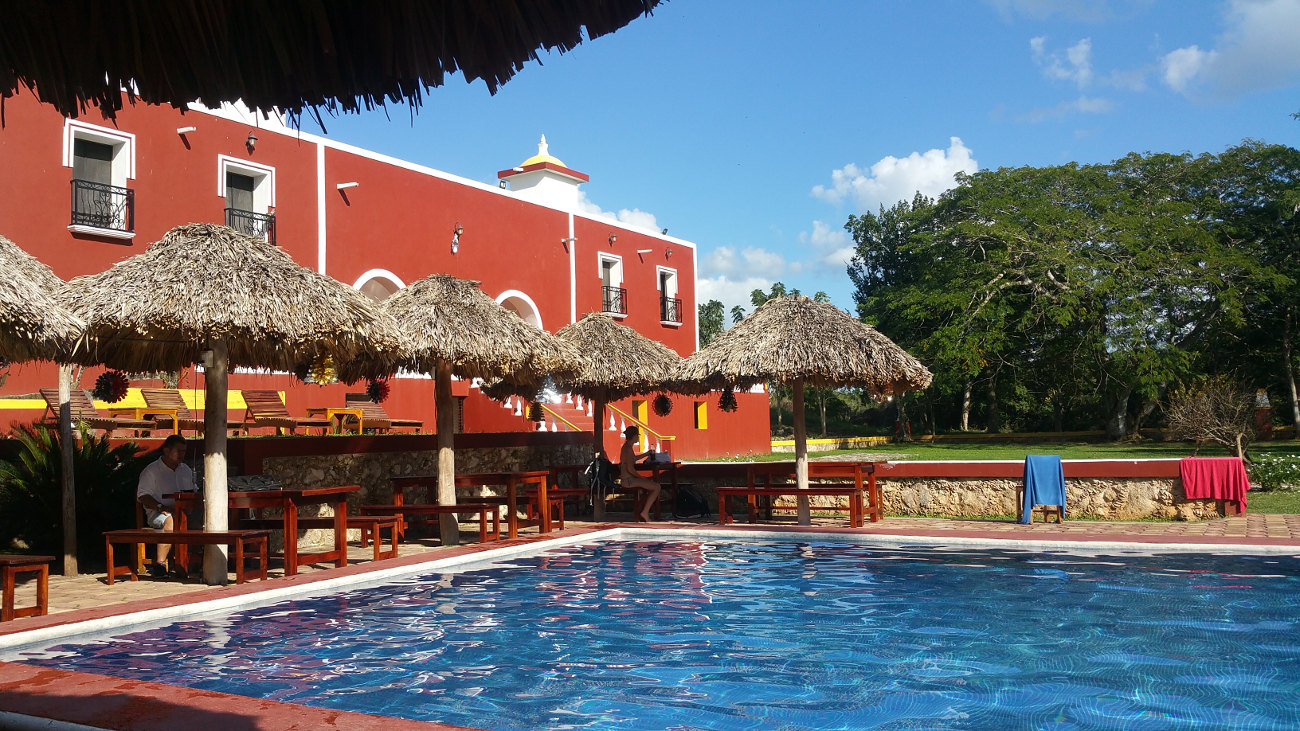
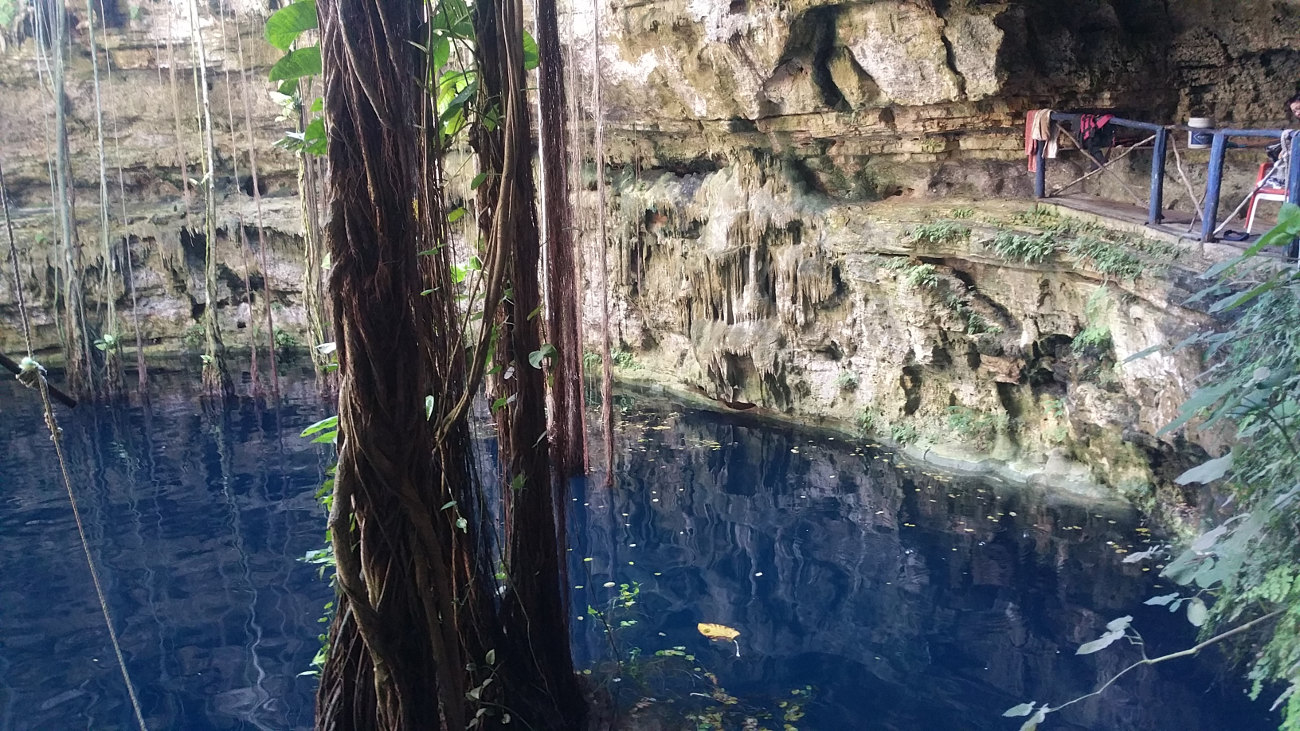 After swimming for a while and taking some pictures I hung around the on-premise restaurant and chatted with some of the other travellers. The Canadian couple also rode bikes over and invited me to lunch along with the two Mexican ladies. We ate at a place that provided botanas, free snacks, with the purchase of beers. They weren't just popcorn or chips but included nachos, pork, chicken and other tasty treats. I joined the Canadian couple again for dinner a few hours later when I finally sought out the traditional and highly recommended Longoniza de Valladolid sausage. We watched the light show again as well. I learned it was shown nighly at the same time and was done in Spanish first then again in English immediately after. I really enjoyed my rest day and was even a little bummed about having to leave Valladolid the next day.
After swimming for a while and taking some pictures I hung around the on-premise restaurant and chatted with some of the other travellers. The Canadian couple also rode bikes over and invited me to lunch along with the two Mexican ladies. We ate at a place that provided botanas, free snacks, with the purchase of beers. They weren't just popcorn or chips but included nachos, pork, chicken and other tasty treats. I joined the Canadian couple again for dinner a few hours later when I finally sought out the traditional and highly recommended Longoniza de Valladolid sausage. We watched the light show again as well. I learned it was shown nighly at the same time and was done in Spanish first then again in English immediately after. I really enjoyed my rest day and was even a little bummed about having to leave Valladolid the next day.
Day 6 — Valladolid to Coba — 47 miles
 I was supposed to follow the same road that took me into Valladolid all the way to Coba but there was another option. There was an unnamed road through small towns that would only add about 10km to my ride and take me where I needed to go. I was rested and chose to take the scenic route. The road was almost completely empty. Very few cars or any other kind of vehicles use these roads. I passed a small town at the beginning of the unnamed stretch and on my way out the distance sign to the next town was 24km. That's a long desolate stretch. In truth there were a few tiny villages just off the road but the only one I checked out contained barely 10 houses. At about the half way point on my ride I crossed state lines into Quintana Roo and the time advanced an hour.
I was supposed to follow the same road that took me into Valladolid all the way to Coba but there was another option. There was an unnamed road through small towns that would only add about 10km to my ride and take me where I needed to go. I was rested and chose to take the scenic route. The road was almost completely empty. Very few cars or any other kind of vehicles use these roads. I passed a small town at the beginning of the unnamed stretch and on my way out the distance sign to the next town was 24km. That's a long desolate stretch. In truth there were a few tiny villages just off the road but the only one I checked out contained barely 10 houses. At about the half way point on my ride I crossed state lines into Quintana Roo and the time advanced an hour. I couldn't find the "welcome to Quintana Roo" sign anywhere but took a picure of the one for Yucatan going the other way. This was a small connecting road and it was very torn up by potholes. I saw one fairly modern black car drive it and take about 10 minutes to manesuver about a mile of beat up road. I was much faster. I decided to stop in the next sizable town since there were not going to be many more. I rode through the town and didn't see much open so I asked some people outside a house if there was a restaurant in town. They said no. Then they said they have some chicken if I wanted to have that. I did. They invited me in to their palapa with wooden branch walls and sat me down at the table. There was a fire going in a fire pit inside. There were several older ladies coming in and out, all but one in traditional Mayan garb. I heard them speaking a language that I was sure was not Spanish.
I couldn't find the "welcome to Quintana Roo" sign anywhere but took a picure of the one for Yucatan going the other way. This was a small connecting road and it was very torn up by potholes. I saw one fairly modern black car drive it and take about 10 minutes to manesuver about a mile of beat up road. I was much faster. I decided to stop in the next sizable town since there were not going to be many more. I rode through the town and didn't see much open so I asked some people outside a house if there was a restaurant in town. They said no. Then they said they have some chicken if I wanted to have that. I did. They invited me in to their palapa with wooden branch walls and sat me down at the table. There was a fire going in a fire pit inside. There were several older ladies coming in and out, all but one in traditional Mayan garb. I heard them speaking a language that I was sure was not Spanish. 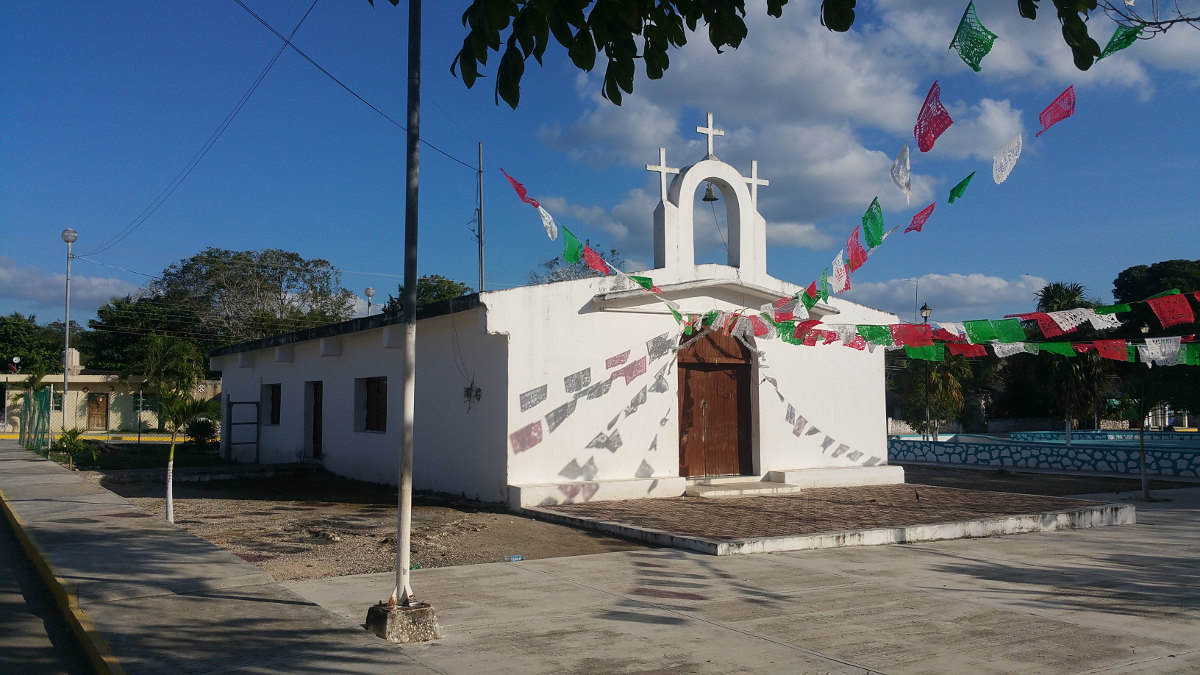 The chicken was served in a faintly spicy black bean stew with homemade tortillas. It was a humble but tasty meal. I was offered some tap water that I declined but I did have some of their Coca-Cola. The lady who invited me in was the first person in my memory who complemented me on my Spanish. We chatted a little bit about where I was from and what I was doing before I needed to get back on the road. Everyone I've met so far has been incredibly hospitable. I made a habit of greeting many of the people I passed and many of them greeted me back. It's hard to believe that people of my complexion used to be killed on sight in this part of the peninsula during the protracted Caste War that lasted from the middle of the 19th century to the 1930s.
The chicken was served in a faintly spicy black bean stew with homemade tortillas. It was a humble but tasty meal. I was offered some tap water that I declined but I did have some of their Coca-Cola. The lady who invited me in was the first person in my memory who complemented me on my Spanish. We chatted a little bit about where I was from and what I was doing before I needed to get back on the road. Everyone I've met so far has been incredibly hospitable. I made a habit of greeting many of the people I passed and many of them greeted me back. It's hard to believe that people of my complexion used to be killed on sight in this part of the peninsula during the protracted Caste War that lasted from the middle of the 19th century to the 1930s.
 When there were about 10 miles left to my destination the landscape shifted from dry and shrubby to dense jungle. The trees were taller and the birds were noticably louder. The change was dramatic and abrupt. I passed the unpaved roads that led to a trio of new cenotes recently opened right outside of Coba. The town itself was tiny but had many businesses catering to the large number of tourists that come in to see the ruins of the same name. I checked my bike and myself into one of the smaller hotels in town and watched a neighbor's pet monkey climb a tree in the next yard. A gentleman walking past me when I arrived struck up a conversation and we decided to get dinner. He was a Romanian living in Belgium who was also traveling alone. We exchanged travel stories. He toured Turkey, Romania and a few other places by bike with an old friend of his. We got tacos at the one place that was open and seemed popular with the locals, then closed down the restaurant bar next door.
When there were about 10 miles left to my destination the landscape shifted from dry and shrubby to dense jungle. The trees were taller and the birds were noticably louder. The change was dramatic and abrupt. I passed the unpaved roads that led to a trio of new cenotes recently opened right outside of Coba. The town itself was tiny but had many businesses catering to the large number of tourists that come in to see the ruins of the same name. I checked my bike and myself into one of the smaller hotels in town and watched a neighbor's pet monkey climb a tree in the next yard. A gentleman walking past me when I arrived struck up a conversation and we decided to get dinner. He was a Romanian living in Belgium who was also traveling alone. We exchanged travel stories. He toured Turkey, Romania and a few other places by bike with an old friend of his. We got tacos at the one place that was open and seemed popular with the locals, then closed down the restaurant bar next door.
Day 7 — Coba to Tulum — 41 miles
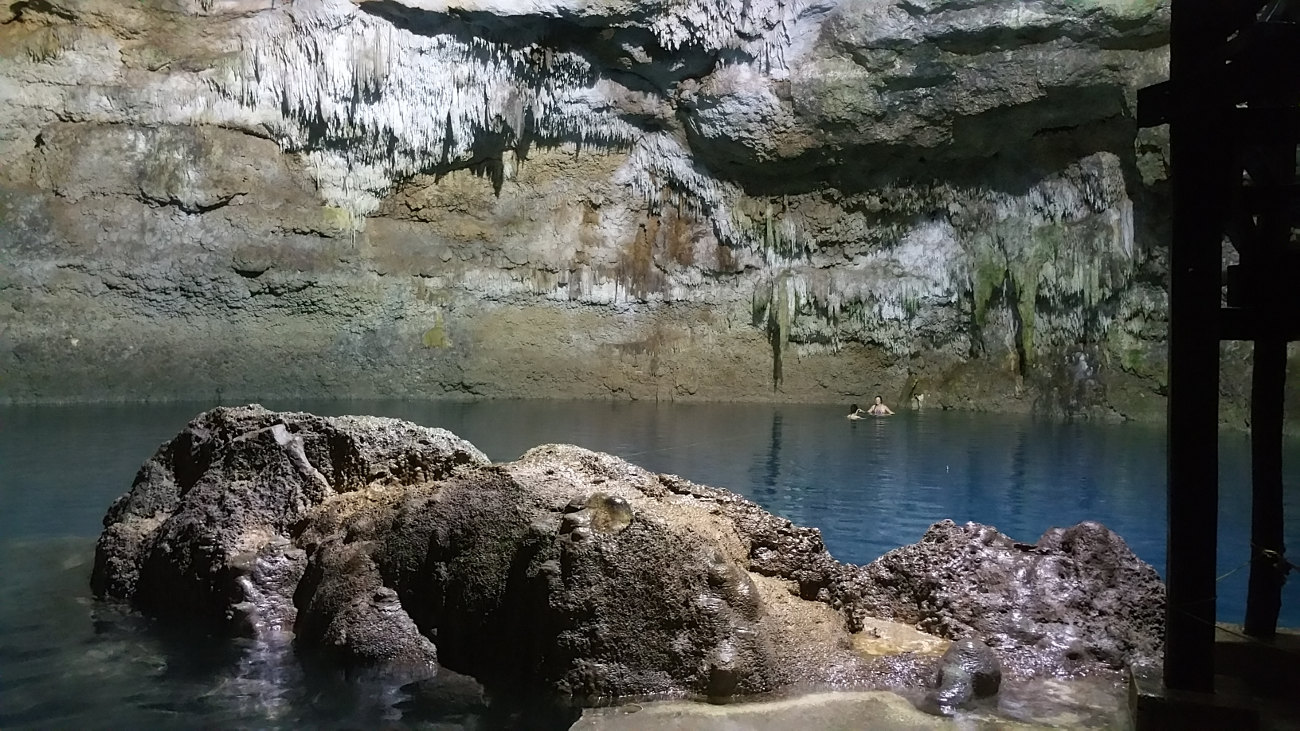
 I got up pretty late and decided to go see the cenotes even though they were in the wrong direction. There were two a few hundred meters apart down one road and another on a separate road. I started with the further one, Multum Ha. I turned off onto a road I passed the day before and rode a longer than expected distance in the hot sun to the cenote entrance. Once there I took a rinse and walked down several long flights of stairs to the subterranean river. There as a large wooden platform and the typical crystal clear water illuminated by dim lights. No one else was there yet, I had it all to myself. The water seemed a little cold at first because the sun wasn't shining on me anymore and I was a fair distance under ground but it felt super warm once I was swimming. After a few minutes of solitude a family from Guadalajara joined me in the water with their young children.
I got up pretty late and decided to go see the cenotes even though they were in the wrong direction. There were two a few hundred meters apart down one road and another on a separate road. I started with the further one, Multum Ha. I turned off onto a road I passed the day before and rode a longer than expected distance in the hot sun to the cenote entrance. Once there I took a rinse and walked down several long flights of stairs to the subterranean river. There as a large wooden platform and the typical crystal clear water illuminated by dim lights. No one else was there yet, I had it all to myself. The water seemed a little cold at first because the sun wasn't shining on me anymore and I was a fair distance under ground but it felt super warm once I was swimming. After a few minutes of solitude a family from Guadalajara joined me in the water with their young children. 
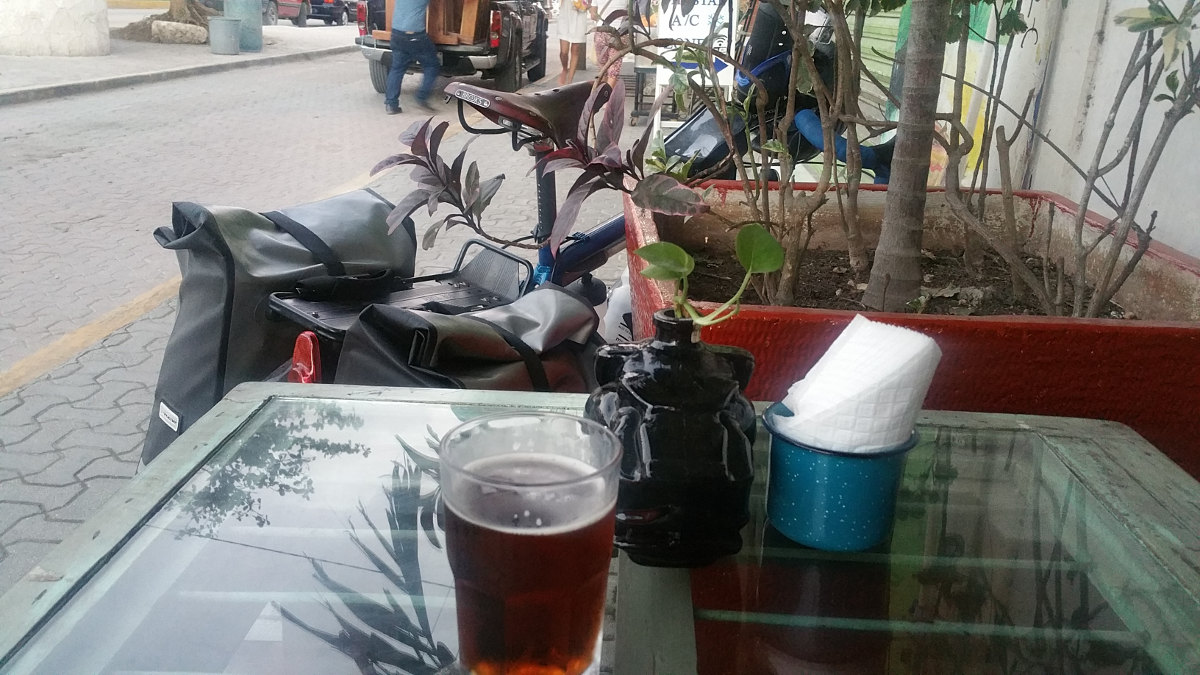 We talked a bit about travel and I got out to go see the other cenotes. The second one, Choo-Ha, had several pools of different depths including a couple shallow ones. It seemed to be more cave-like with numerous stalactites and bats flying around all over the place. I took a short dip and proceeded to Tankach-Ha. This one was more of a circle and had a beautiful blue hue. There was a really high diving platform as you came down the wooden stairs. At the bottom there was a concrete platform that was submerged about 6 inches into the water. Little catfish were swimming around right where I was standing. I wondered how long the wooden parts that were under water would last before having to be replaced. I swam a little more before getting dressed and riding back into town. Unlike the day before I didn't have a small road option to get to Tulum as much as I wished there was. My ride ended with a fairly uneventful stretch along the shoulder of road 109 all the way to Tulum.
We talked a bit about travel and I got out to go see the other cenotes. The second one, Choo-Ha, had several pools of different depths including a couple shallow ones. It seemed to be more cave-like with numerous stalactites and bats flying around all over the place. I took a short dip and proceeded to Tankach-Ha. This one was more of a circle and had a beautiful blue hue. There was a really high diving platform as you came down the wooden stairs. At the bottom there was a concrete platform that was submerged about 6 inches into the water. Little catfish were swimming around right where I was standing. I wondered how long the wooden parts that were under water would last before having to be replaced. I swam a little more before getting dressed and riding back into town. Unlike the day before I didn't have a small road option to get to Tulum as much as I wished there was. My ride ended with a fairly uneventful stretch along the shoulder of road 109 all the way to Tulum.
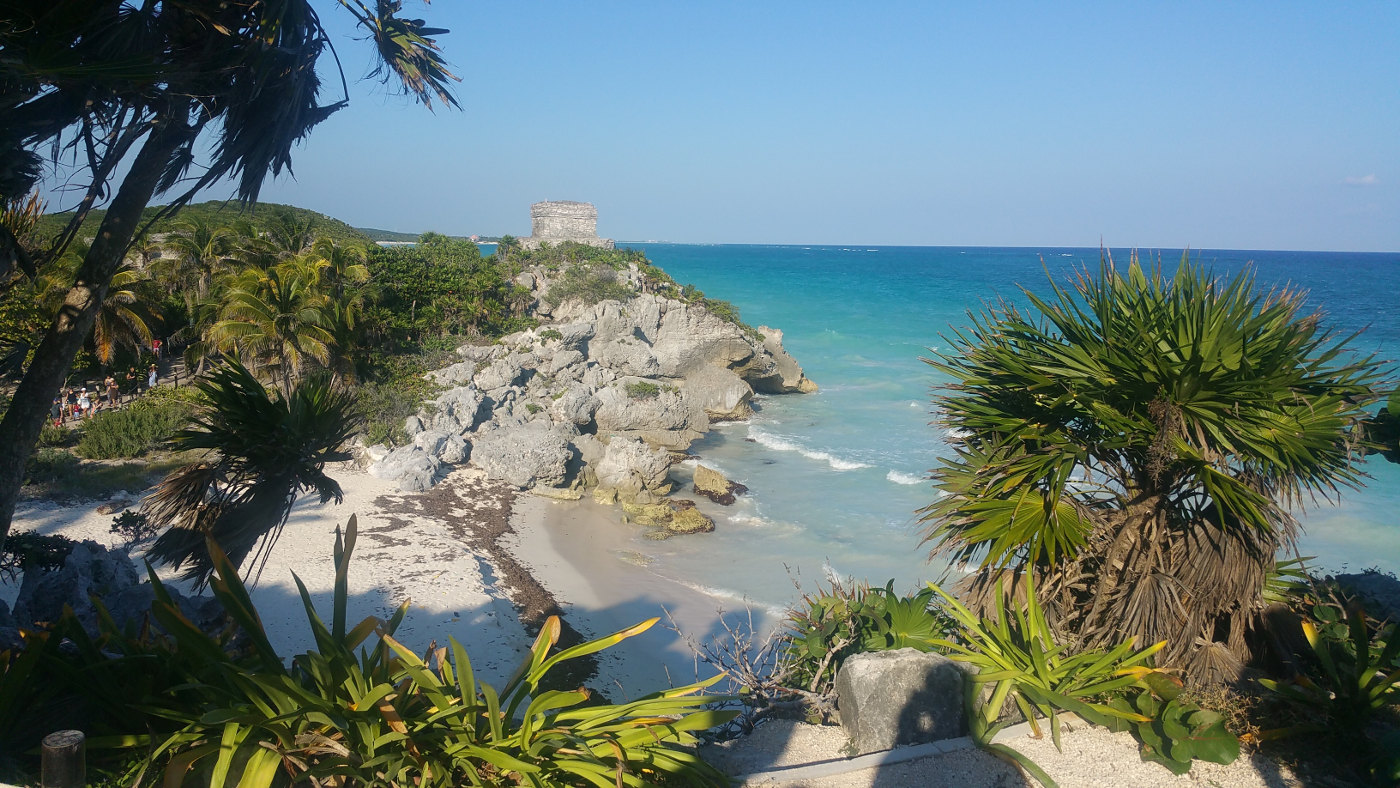 I spent the next 3 days relaxing with family before the flight home. The Tulum ruins were spectacular in part because of the well preserved buildings but also because of the beachfront setting. We checked out the local beaches, ate loads of seafood, and explored the town. Not a bad way to spend the holidays. Luckily for less festive people like myself there wasn't too much ado about the holidays in Mexico except for some decorations and a few parades geared towards children. The last task I had to accomplish was locating a box to ship my bike. They gouged me pretty heavily on the way and I was determined to outsmart them coming back. Gina's carrier pigeon told me she got away without paying the huge fee and I wanted to pack my bike the same way she did hers. I looked around town but most of the tourist shops had nothing. I went to the market, which looked at about 30% capacity due to the fact that it was Christmas. They told me to try the supermarket and I found a lot of different boxes.
I spent the next 3 days relaxing with family before the flight home. The Tulum ruins were spectacular in part because of the well preserved buildings but also because of the beachfront setting. We checked out the local beaches, ate loads of seafood, and explored the town. Not a bad way to spend the holidays. Luckily for less festive people like myself there wasn't too much ado about the holidays in Mexico except for some decorations and a few parades geared towards children. The last task I had to accomplish was locating a box to ship my bike. They gouged me pretty heavily on the way and I was determined to outsmart them coming back. Gina's carrier pigeon told me she got away without paying the huge fee and I wanted to pack my bike the same way she did hers. I looked around town but most of the tourist shops had nothing. I went to the market, which looked at about 30% capacity due to the fact that it was Christmas. They told me to try the supermarket and I found a lot of different boxes. 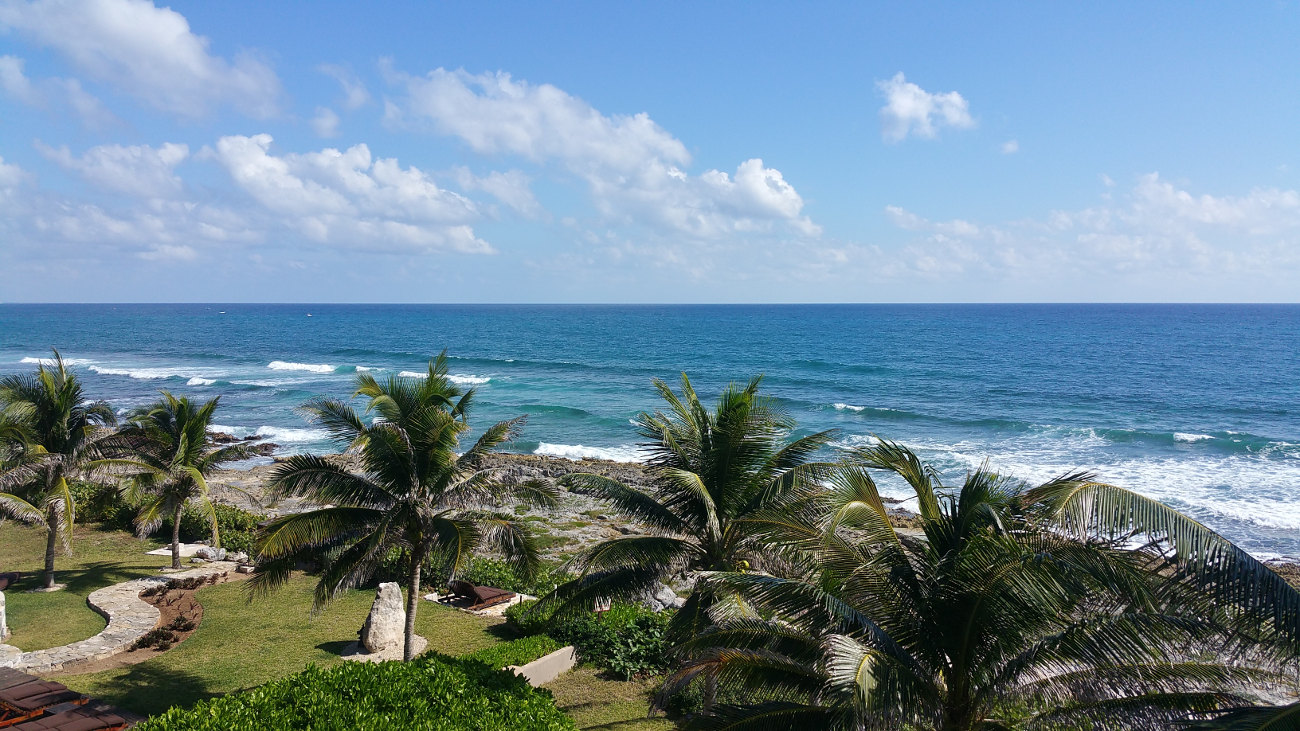 I left a tip for a gentleman who helped me pick out 3 or 4 of the larger ones that I planned to tape together even though they were a little on the thin side. I started packing them when my mom mentioned she saw some large boxes in the basement of the house we were staying in. I checked and there was an empty air conditioner box that was perfect for the job. At the airport they asked me what was in the box and I made up some lame story about souvenirs. The lady at the counter asked me to open the box. I said I didn't have any scissors so she brought some over. I nervously cut the tape, little by little, until I could pull out one of the pieces of styrofoam I shoved in there for protection. She looked in and said, "oh, bike parts." By this point the boy working the counter had already charged me the regular bag fee and I thanked them both and went to the gate.
I left a tip for a gentleman who helped me pick out 3 or 4 of the larger ones that I planned to tape together even though they were a little on the thin side. I started packing them when my mom mentioned she saw some large boxes in the basement of the house we were staying in. I checked and there was an empty air conditioner box that was perfect for the job. At the airport they asked me what was in the box and I made up some lame story about souvenirs. The lady at the counter asked me to open the box. I said I didn't have any scissors so she brought some over. I nervously cut the tape, little by little, until I could pull out one of the pieces of styrofoam I shoved in there for protection. She looked in and said, "oh, bike parts." By this point the boy working the counter had already charged me the regular bag fee and I thanked them both and went to the gate.
Conclusion
 I might have expected at least a flat tire, bad weather, or some kind of body ache but apart from Gina's sickness things went smoothly. The fact that I speak a little Spanish helped me a great deal and the GPS on my phone was indispensable. Bottled water was easy to find almost everywhere as were decent inexpensive accomodations as long as you were in one of the larger towns. If I planned this trip again I'd try to get on the road earlier due to to how little sun is available in winter. It's nicer not to have to rush. I'm also shopping for large soft duffel bags I can hide a bike in to avoid the airline fees (coming over it was over $100 and the airline I chose was known to be bike-friendly).
I might have expected at least a flat tire, bad weather, or some kind of body ache but apart from Gina's sickness things went smoothly. The fact that I speak a little Spanish helped me a great deal and the GPS on my phone was indispensable. Bottled water was easy to find almost everywhere as were decent inexpensive accomodations as long as you were in one of the larger towns. If I planned this trip again I'd try to get on the road earlier due to to how little sun is available in winter. It's nicer not to have to rush. I'm also shopping for large soft duffel bags I can hide a bike in to avoid the airline fees (coming over it was over $100 and the airline I chose was known to be bike-friendly).
Gear
My bike was an aluminum frame, carbon fork cyclocross cheapie I put together with a MTN bike triple crank, bar end shifters, and a reasonably wide range 10-speed cassette. My tires were 700x37 Continental Travel Contacts and they performed really well. The roads were well paved and while I wouldn't care to ride it on 23mm tires I'd say thick tires aren't necessary for 90% of the roads I encountered in the Yucatan. My rack had a pair of large panniers that were hardly ever full. I also had a tiny top tube bag for my phone and few small things. I wore jean shorts and either a cotton t-shirt or a cycling jersey. I had double sided SPDs pedals with SPD shoes. I had spare tubes, spokes and some basic tools along with a frame pump. I had a big bluetooth speaker that I only used a few times and a cheap waterproof camera mounted to the handlebars.